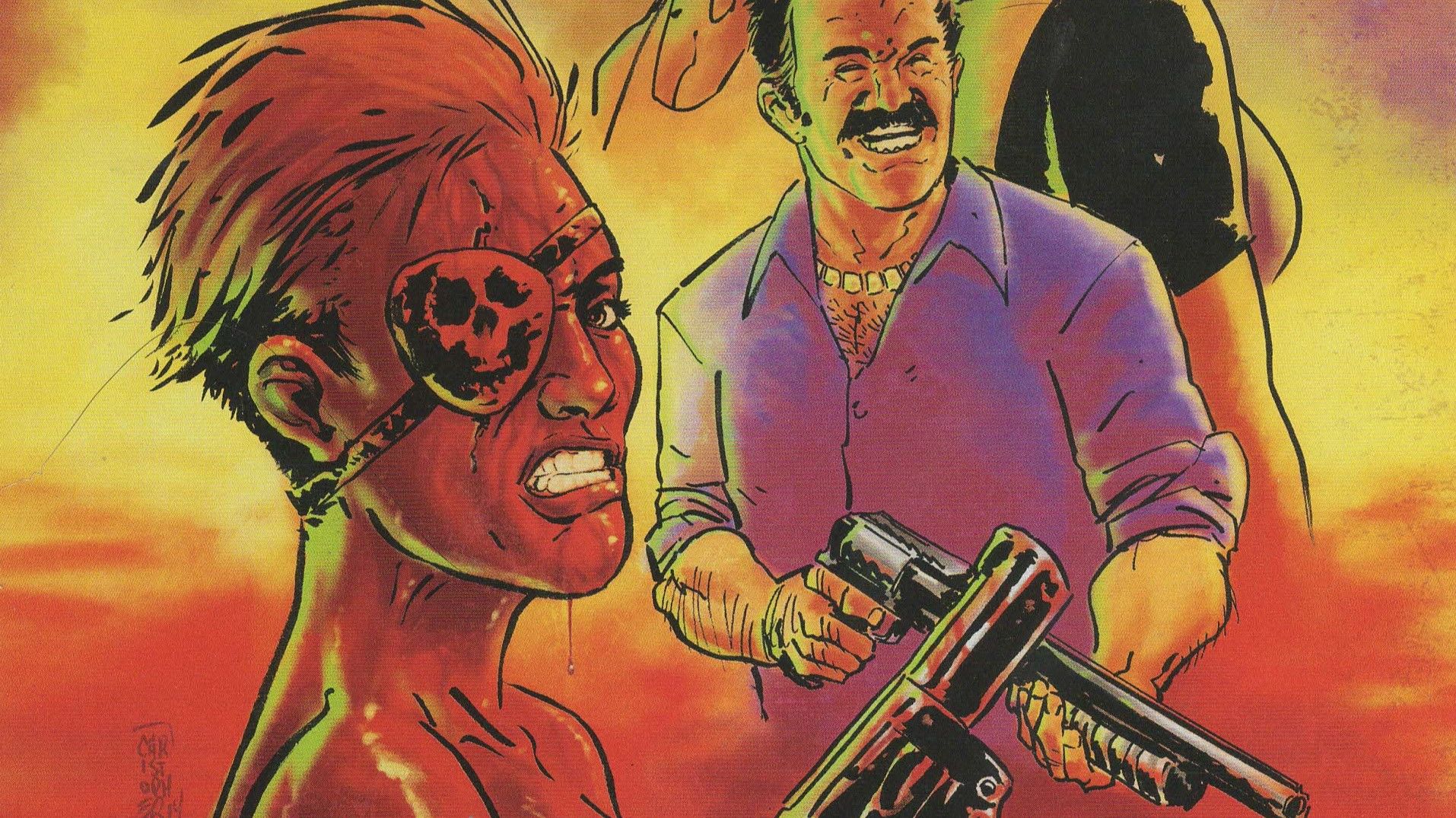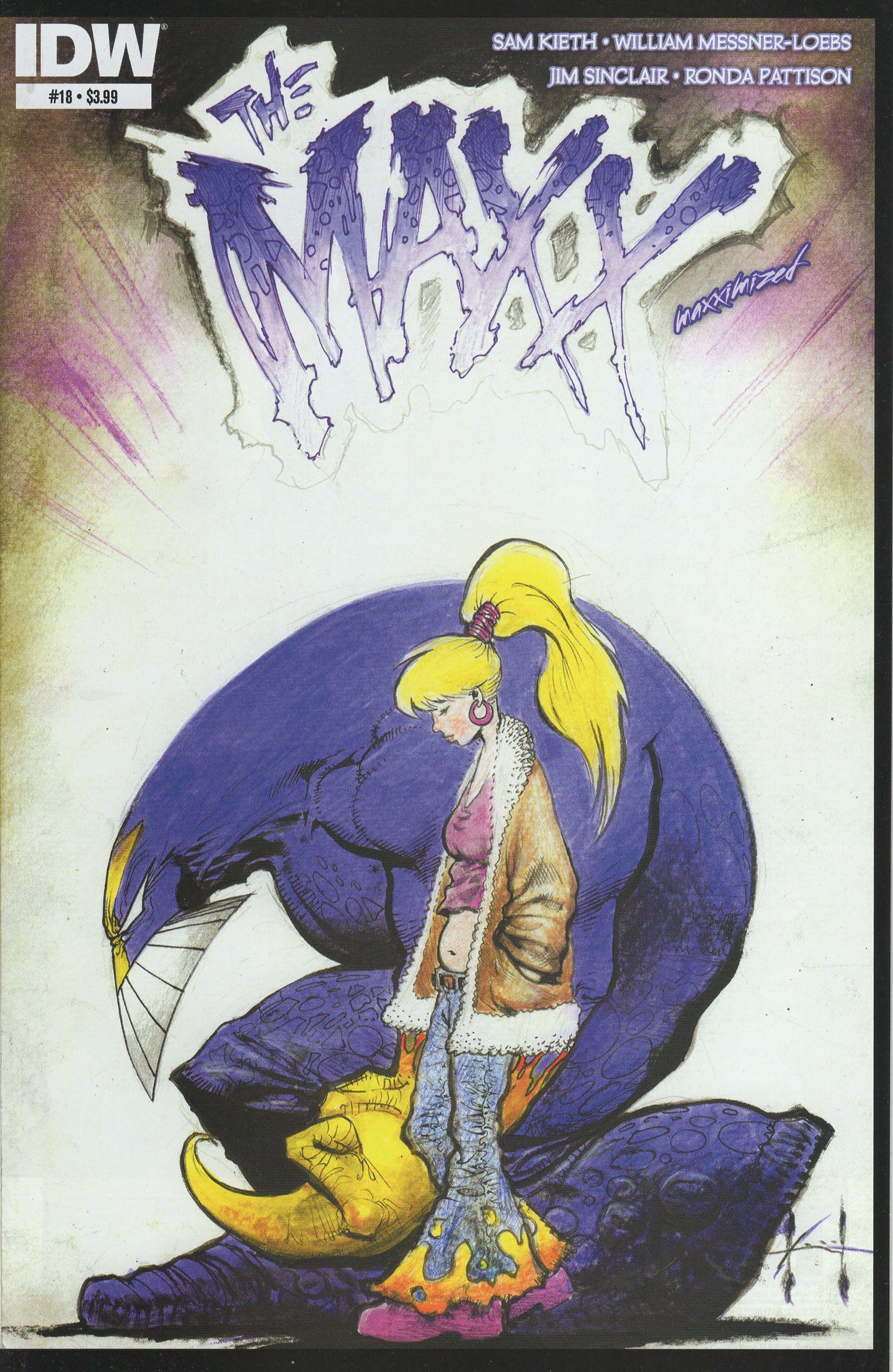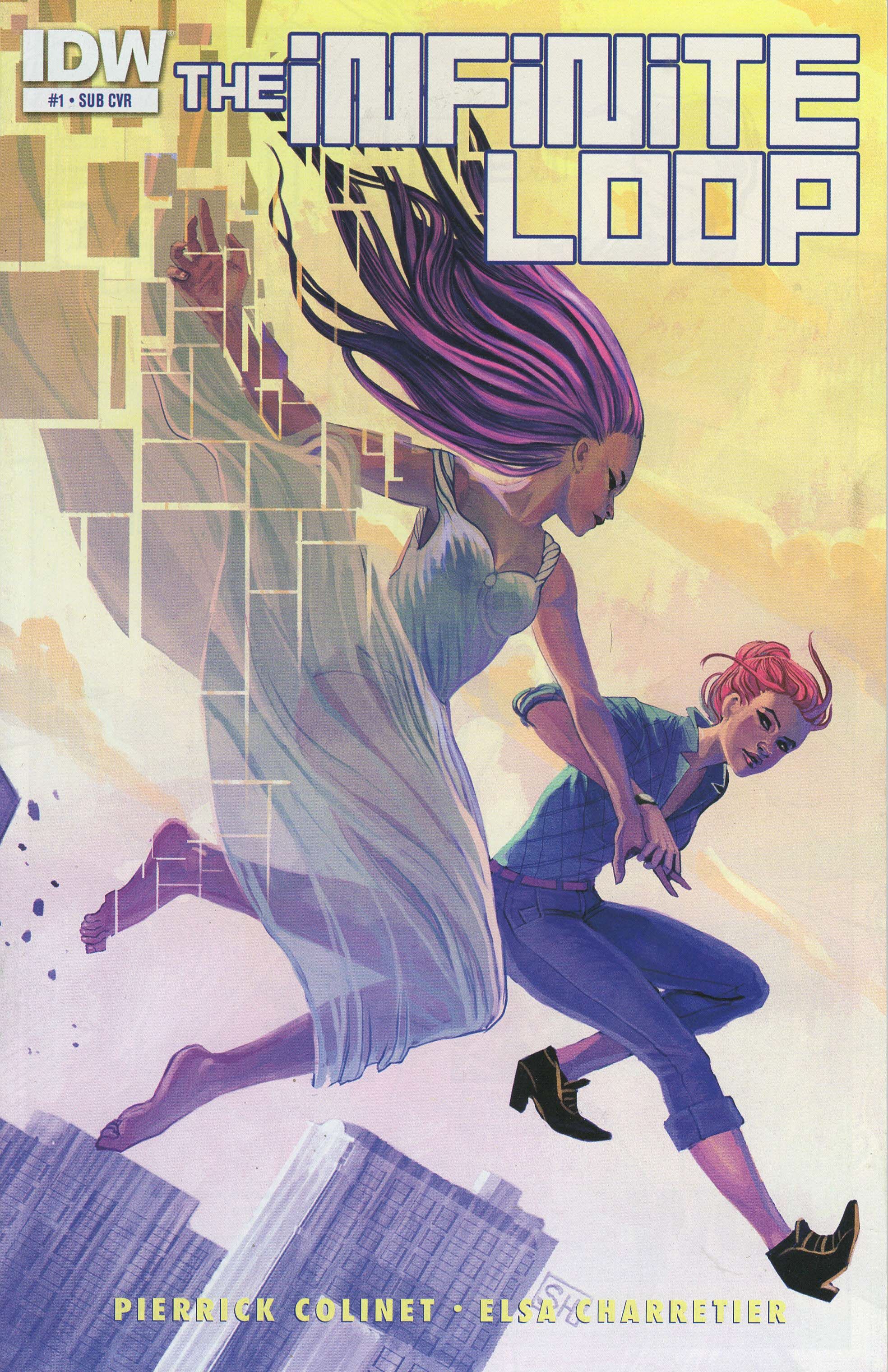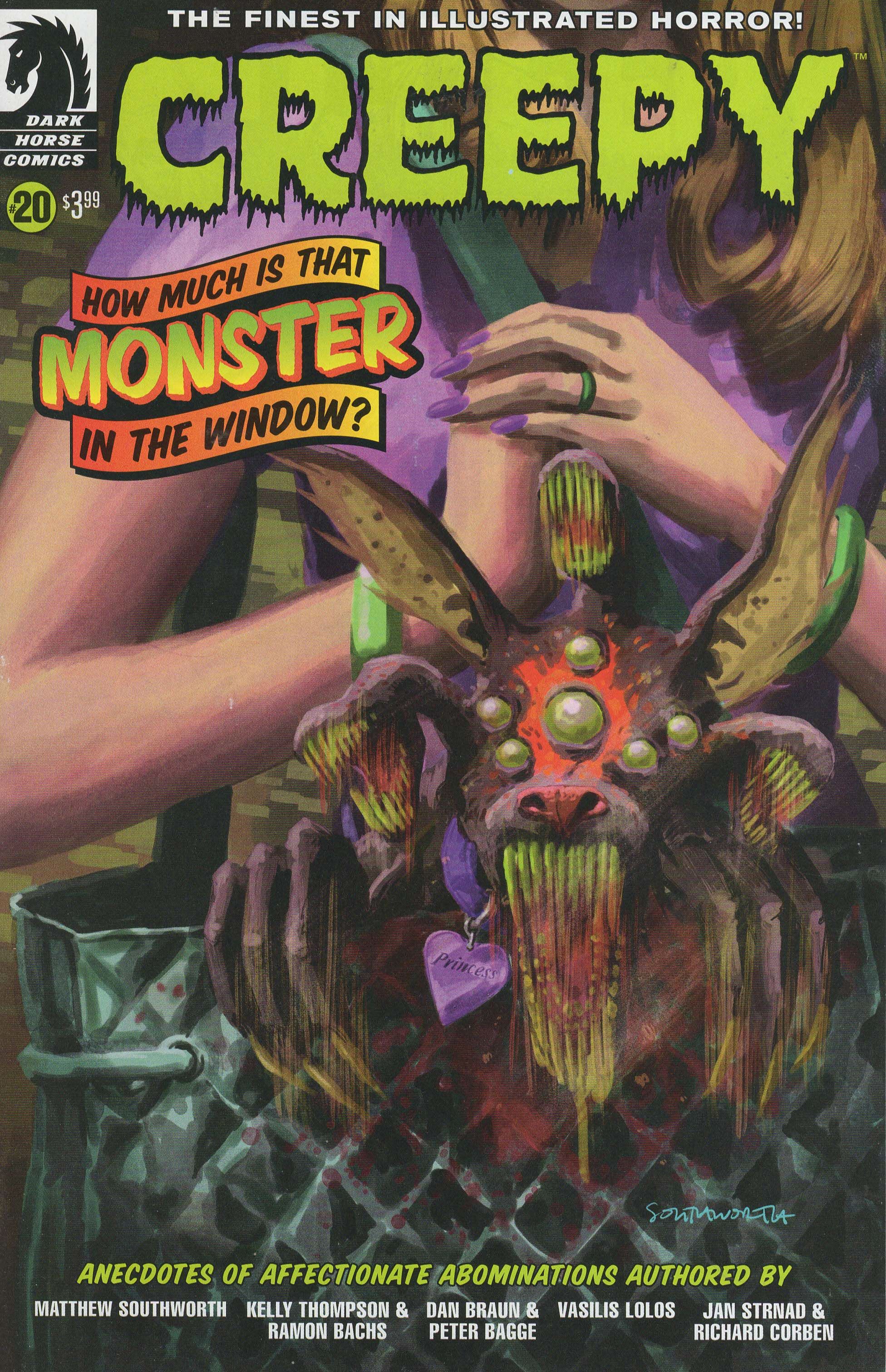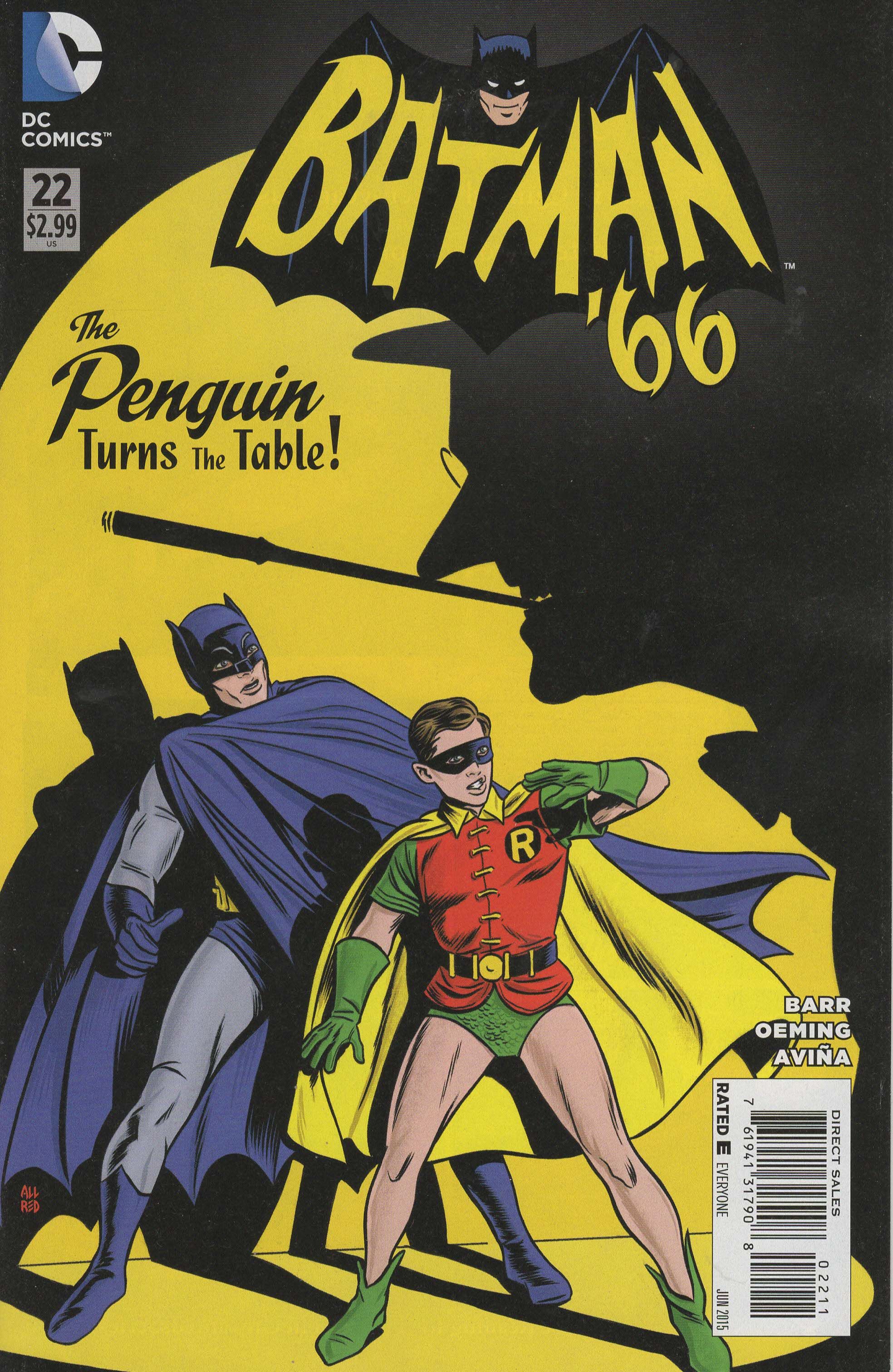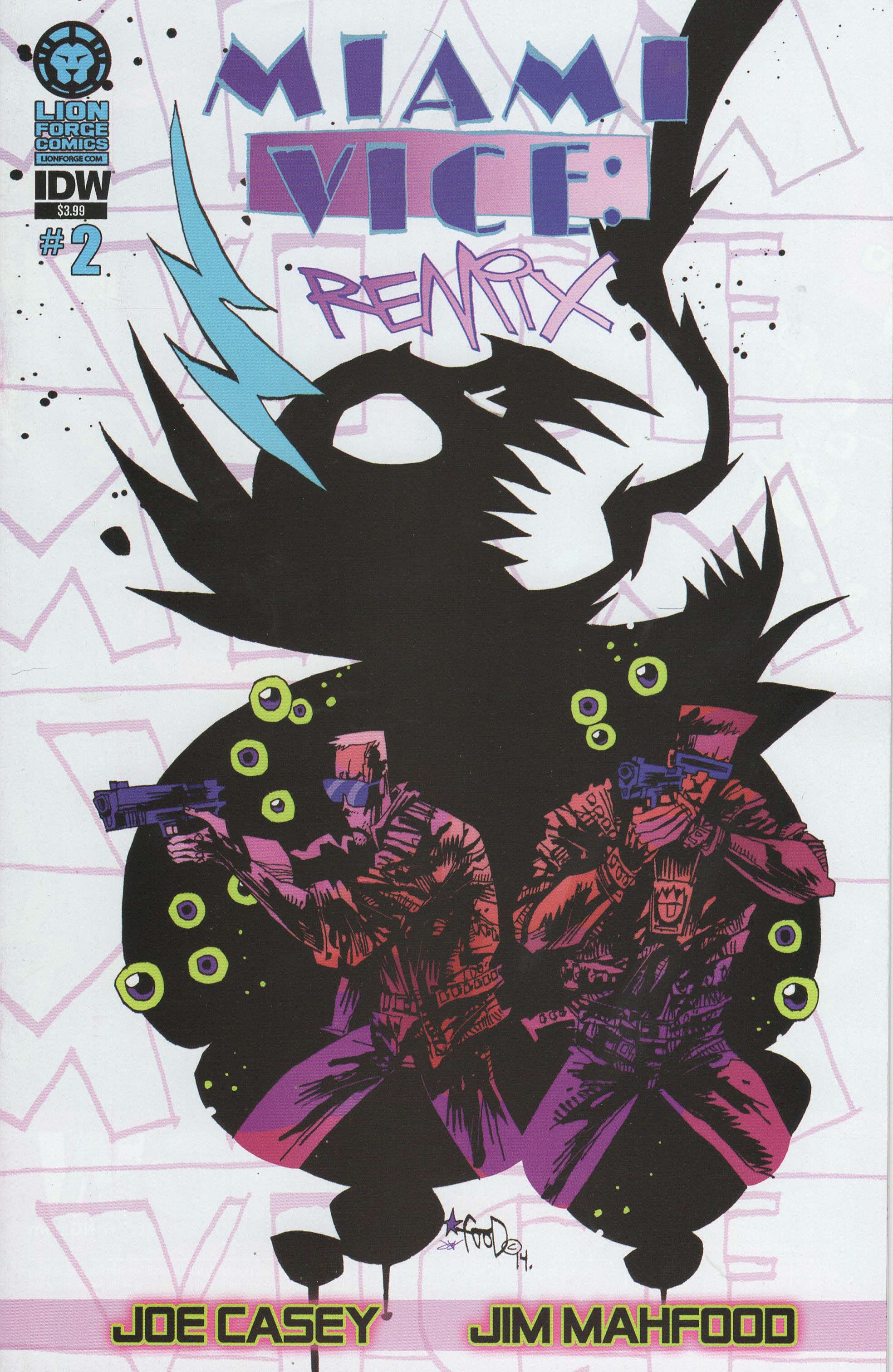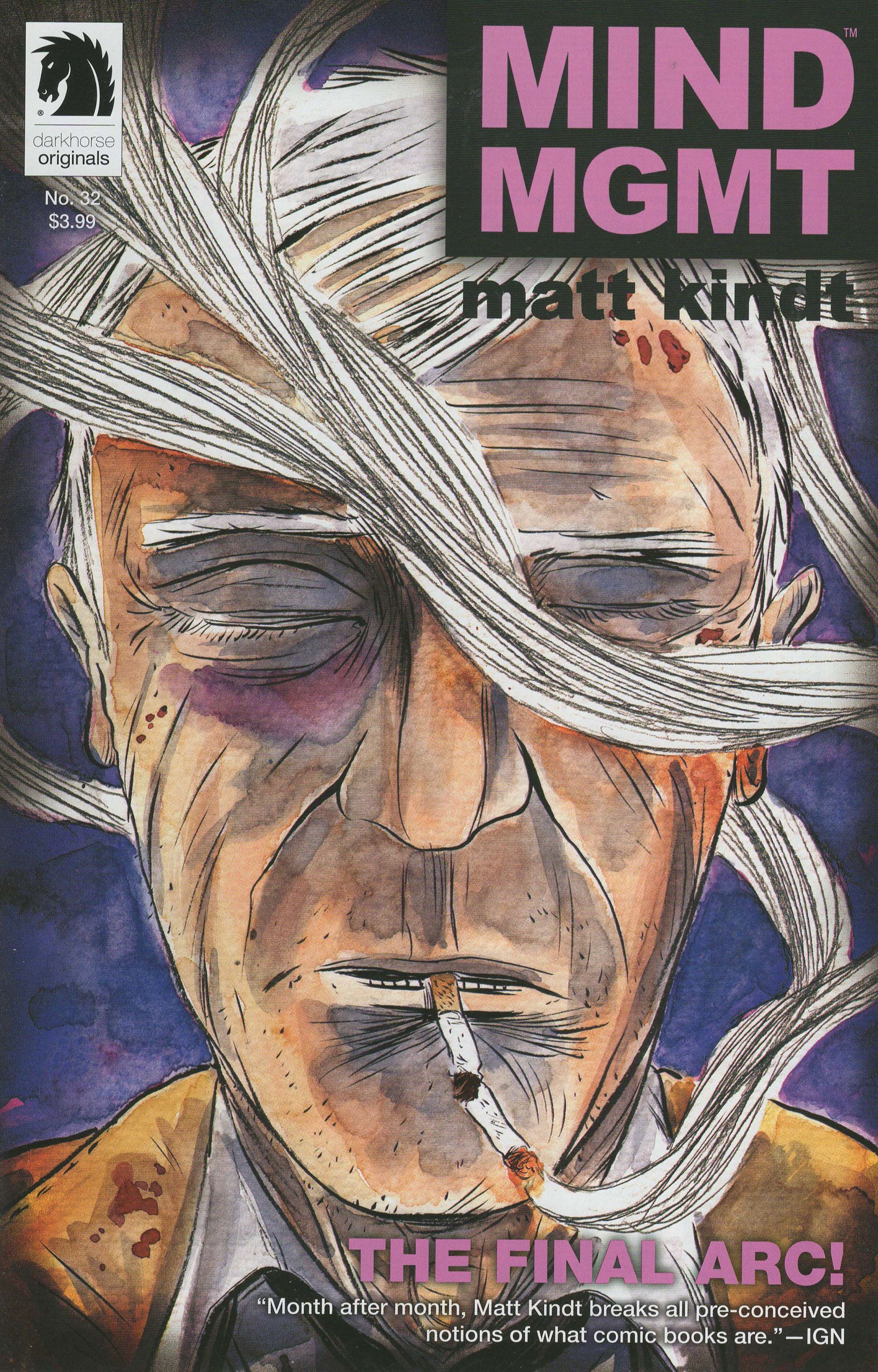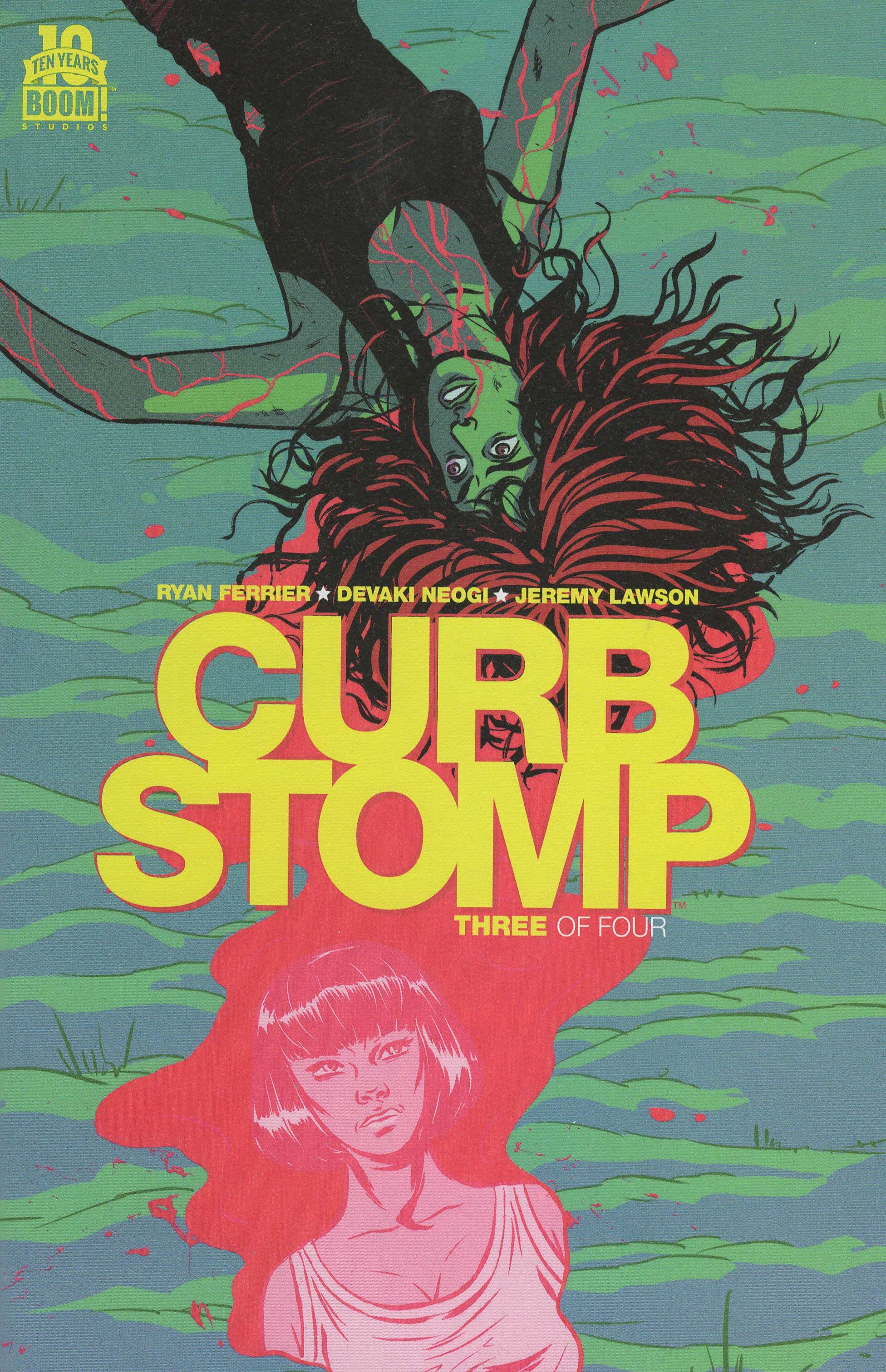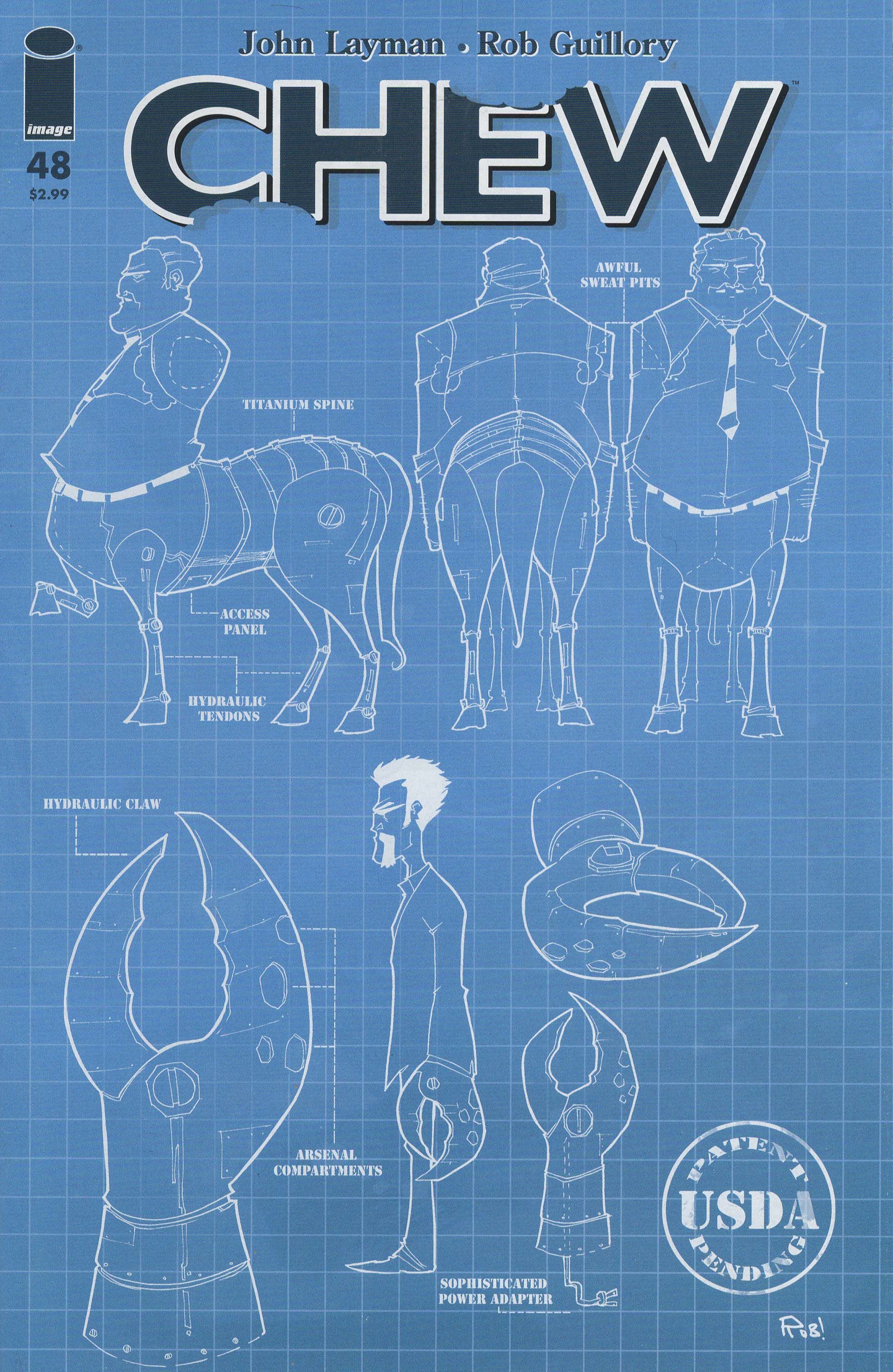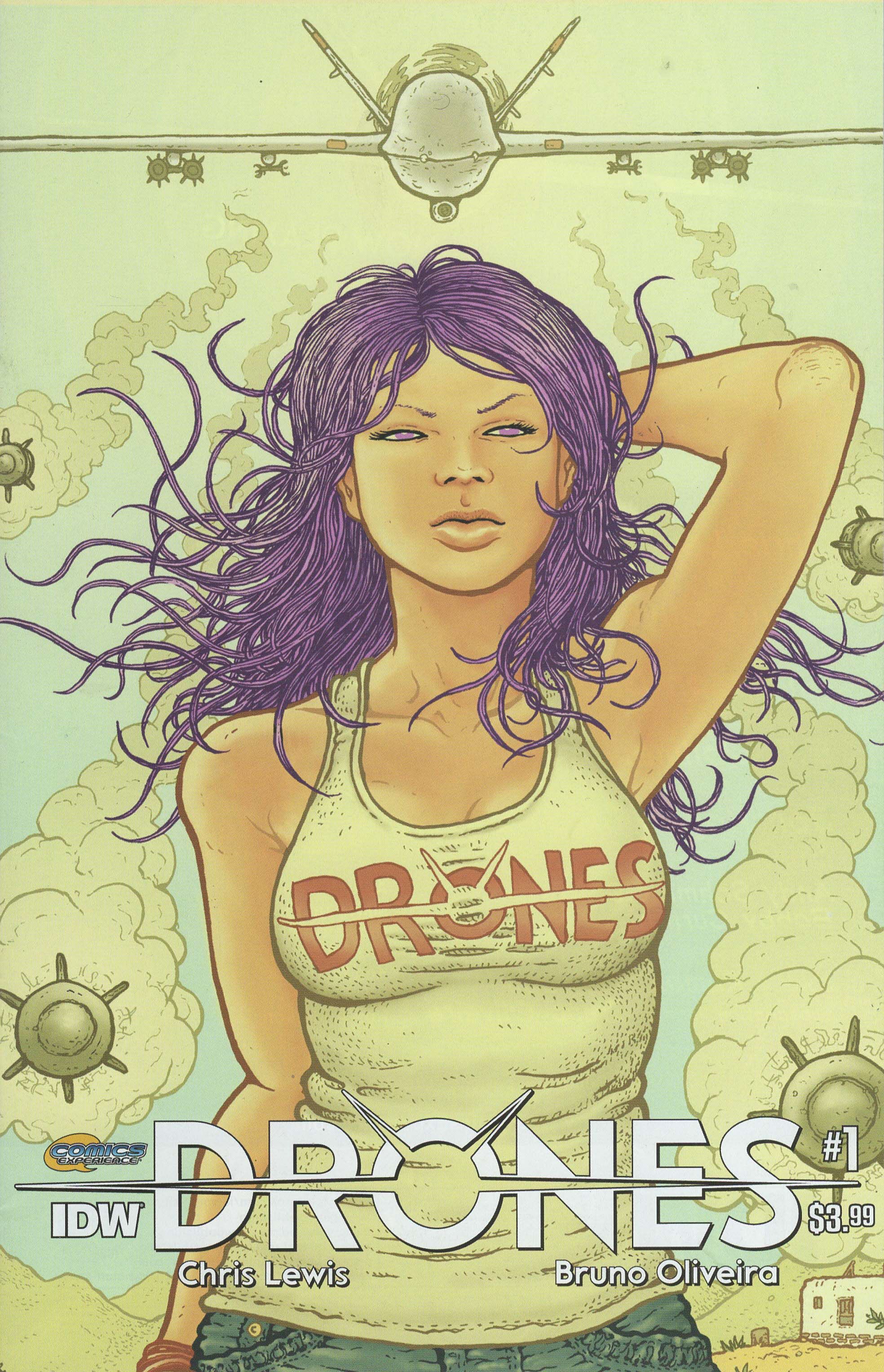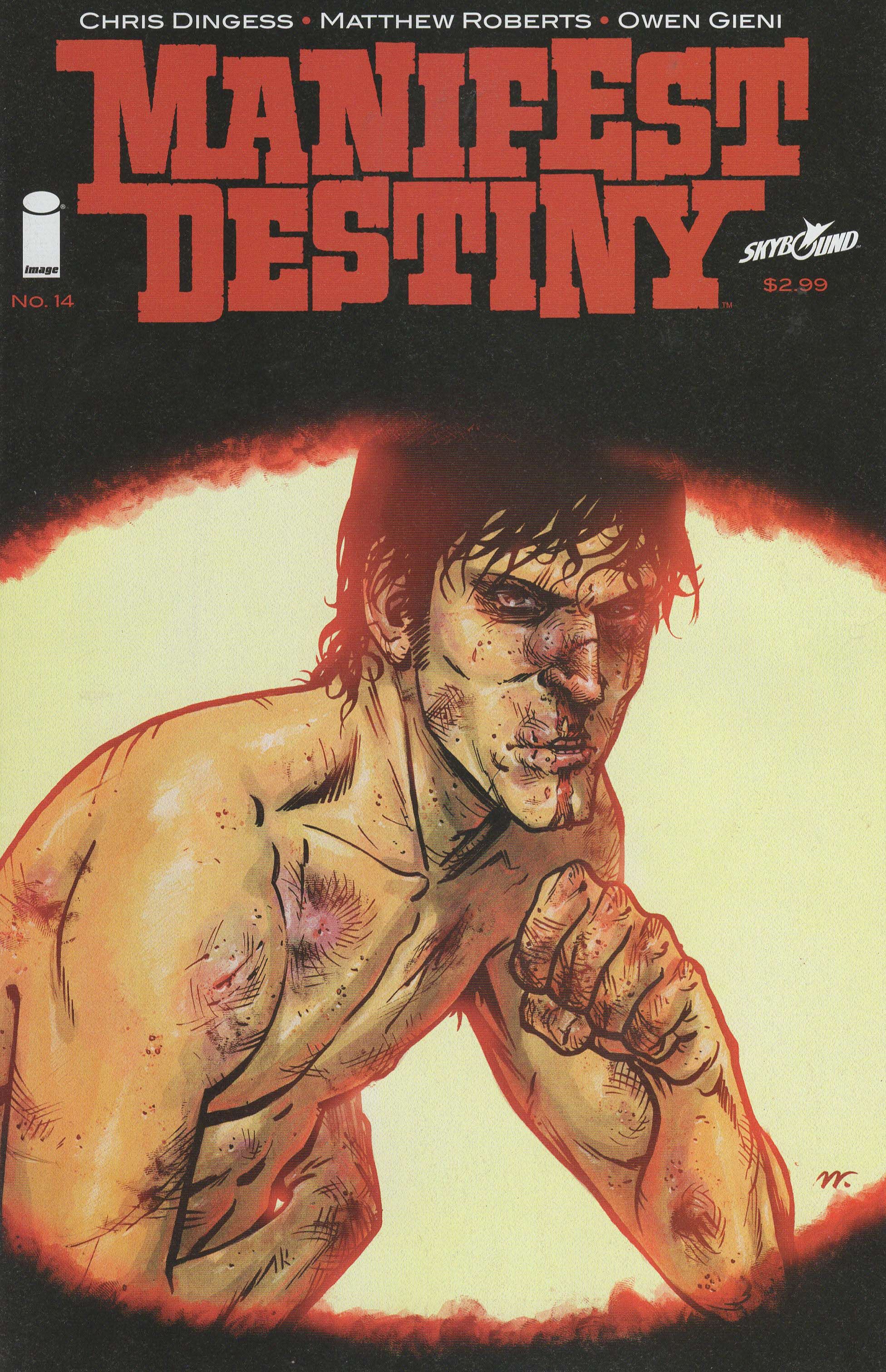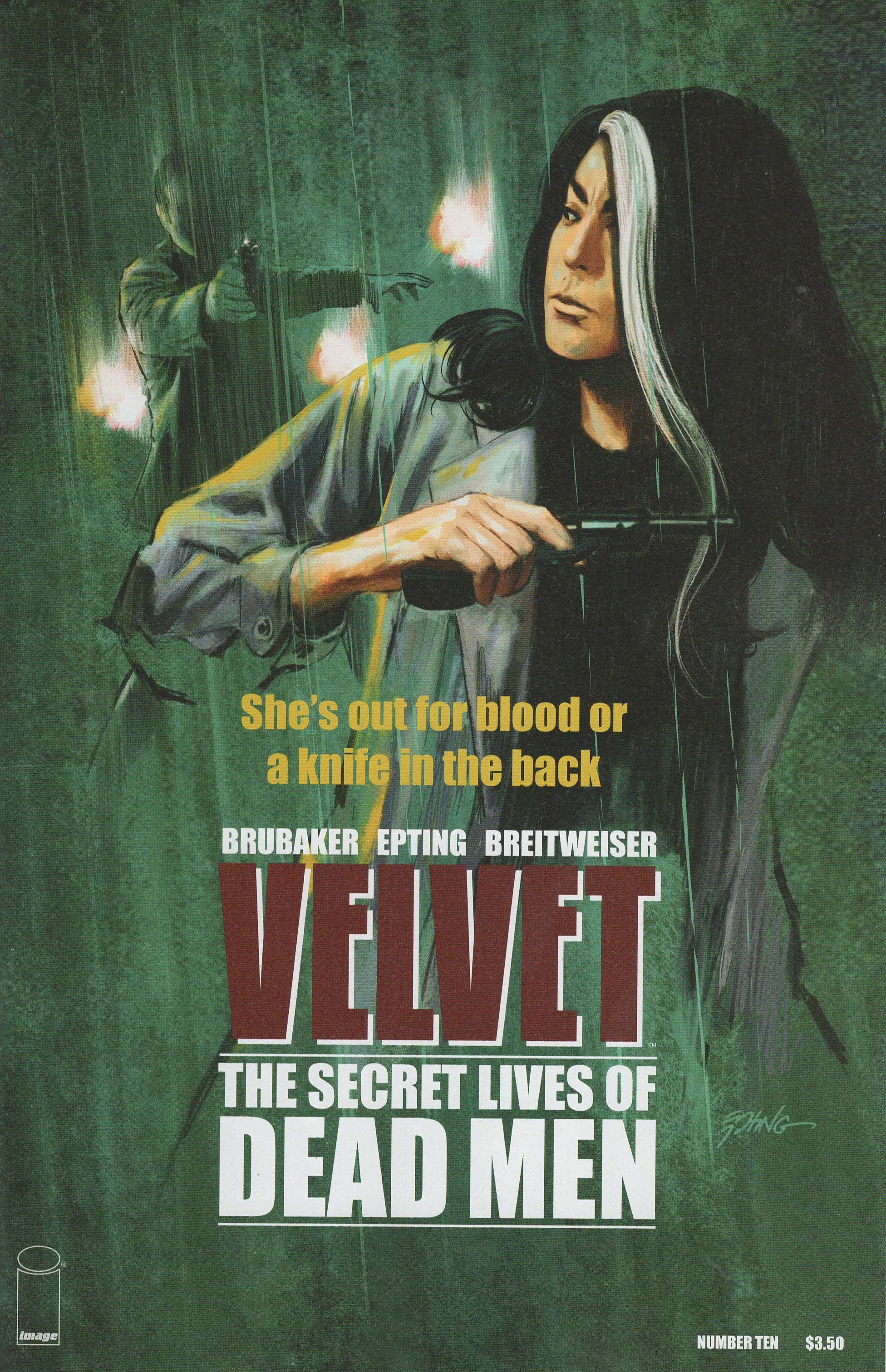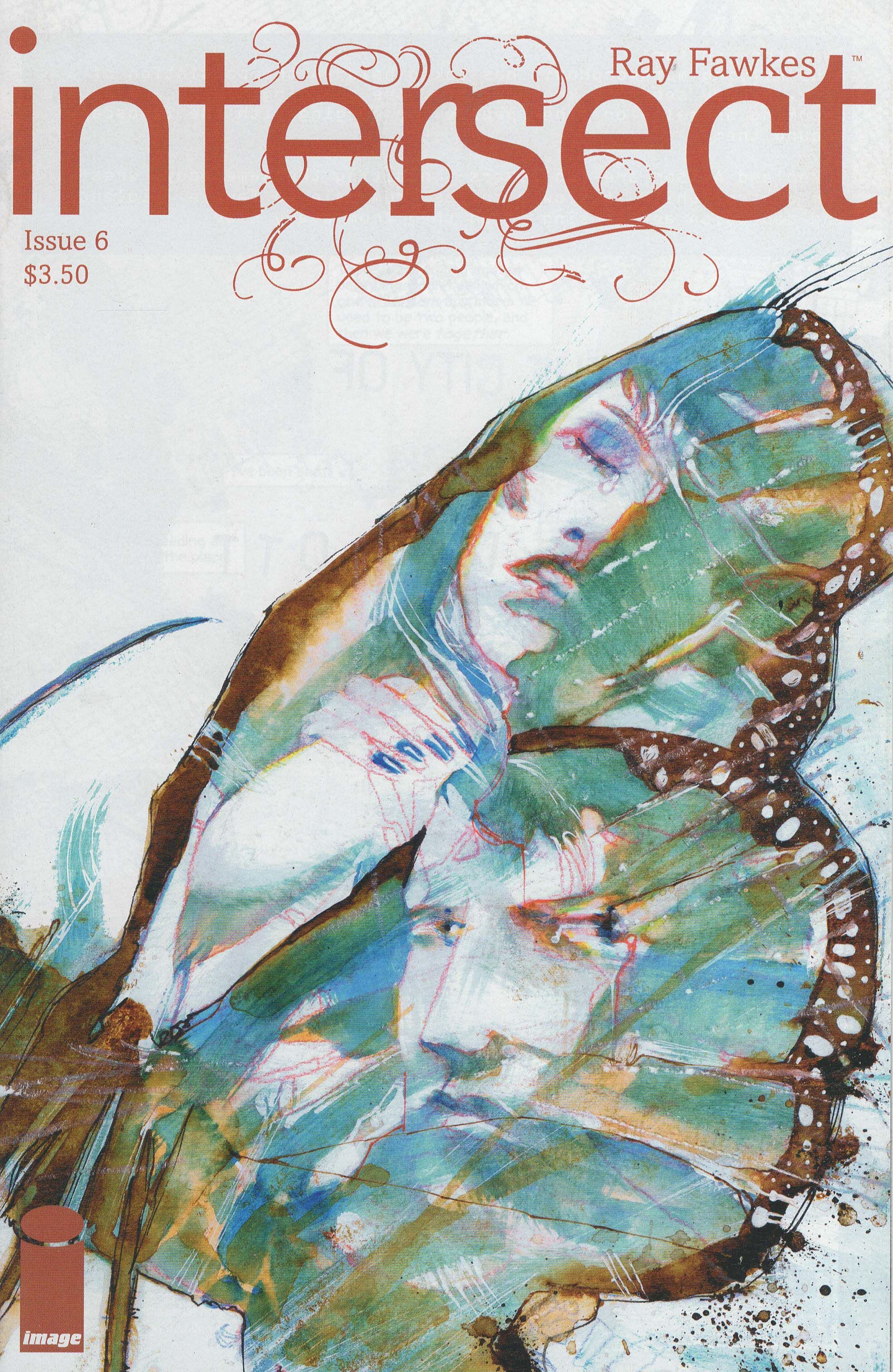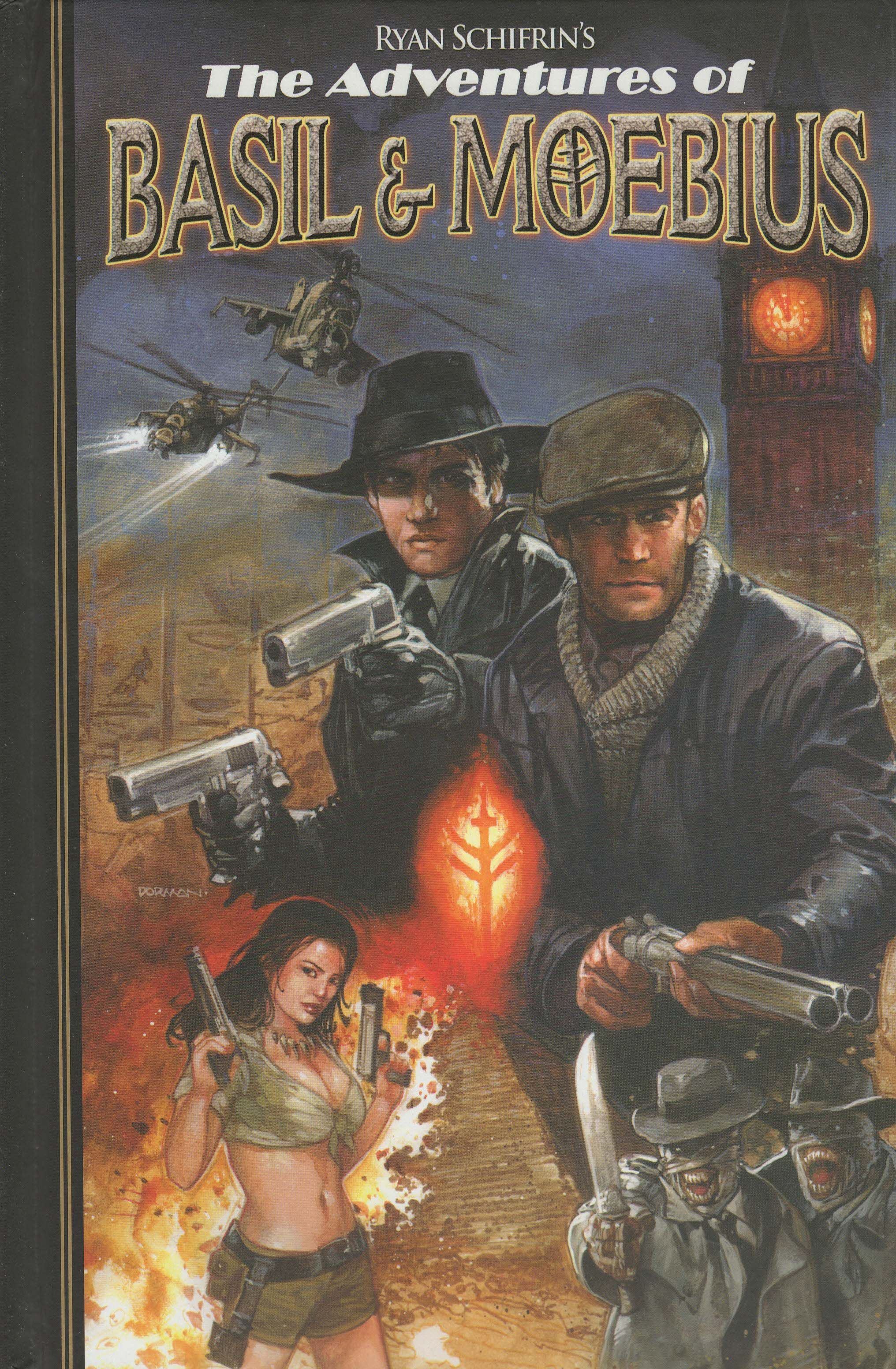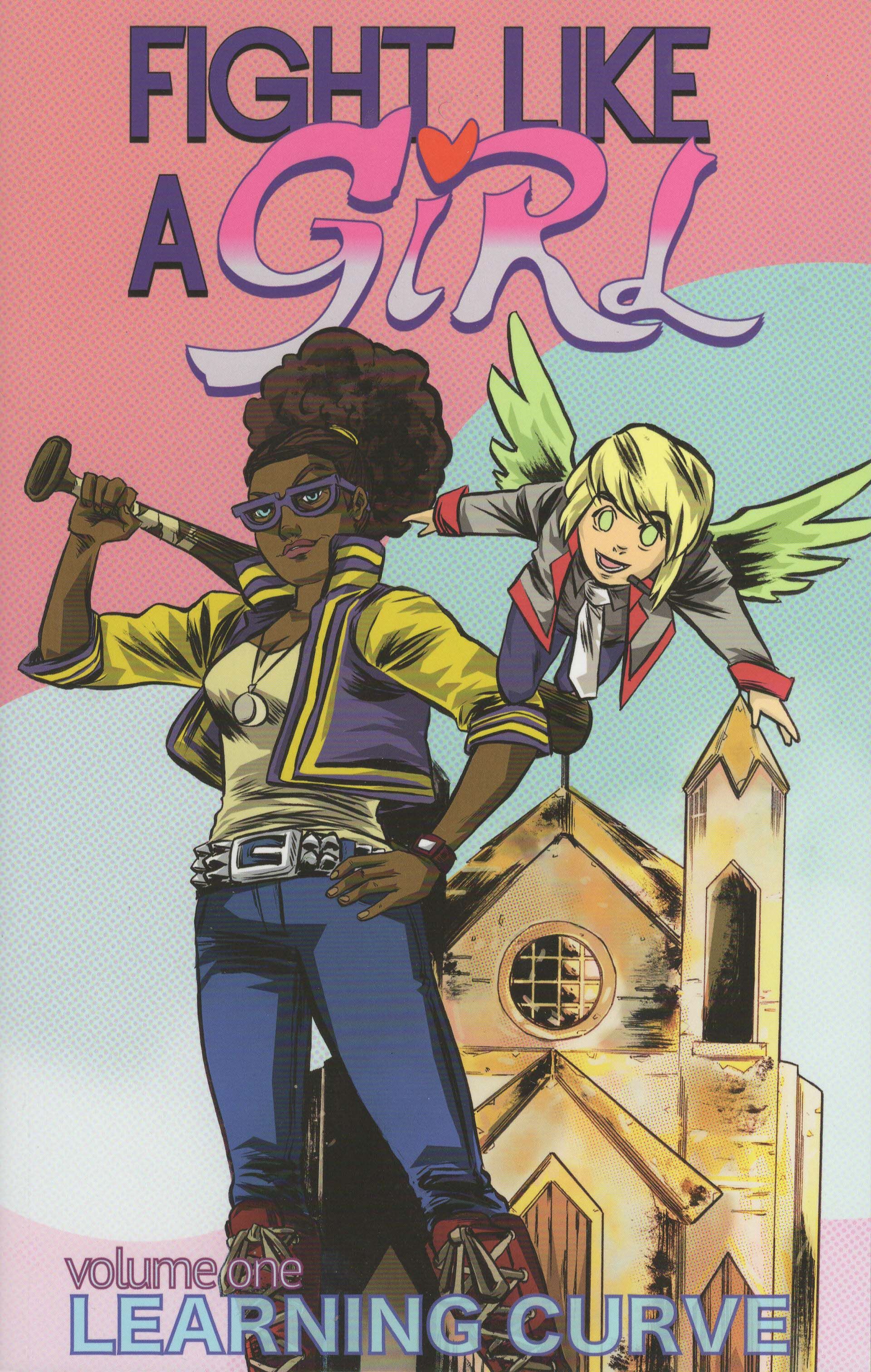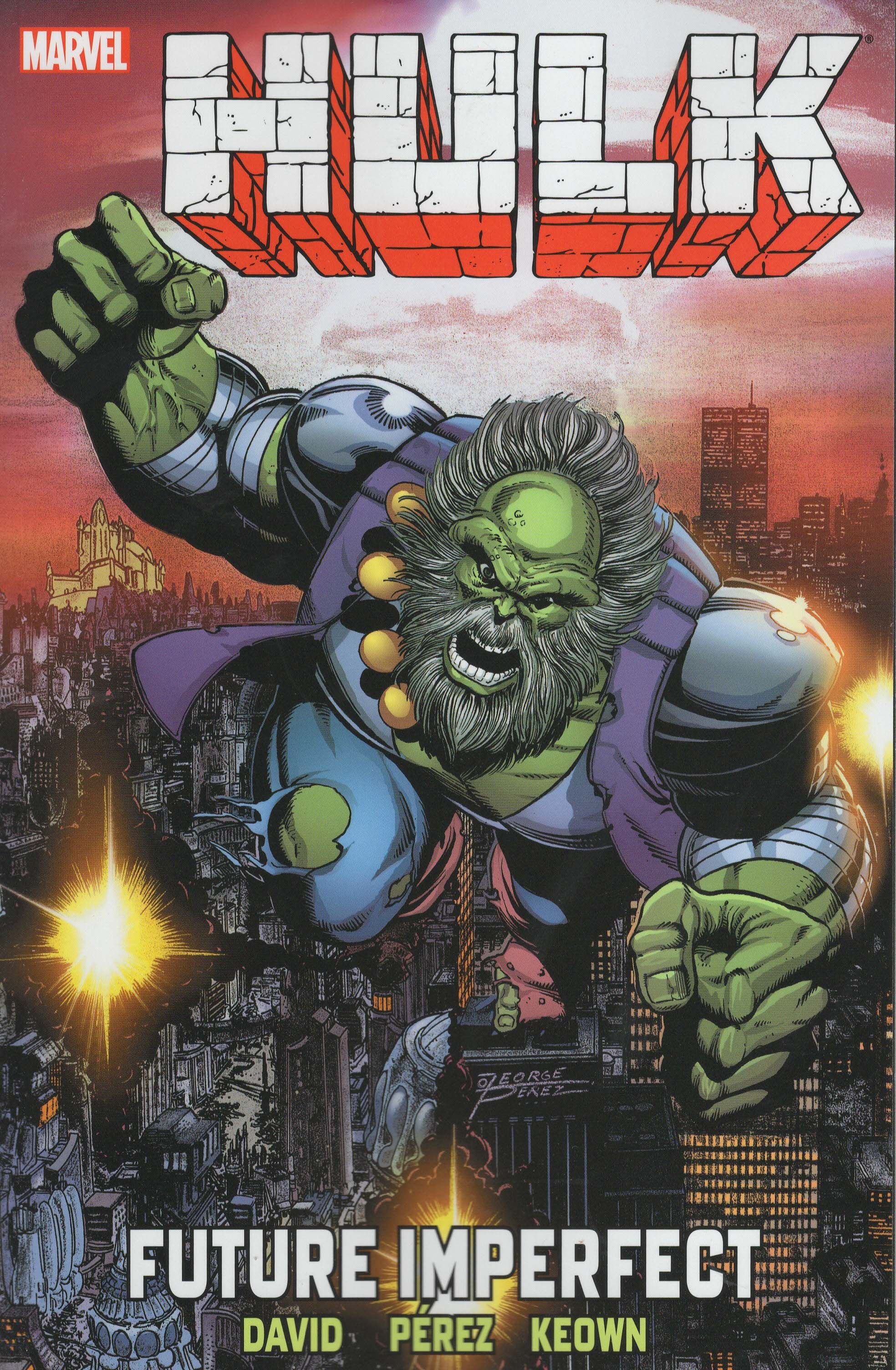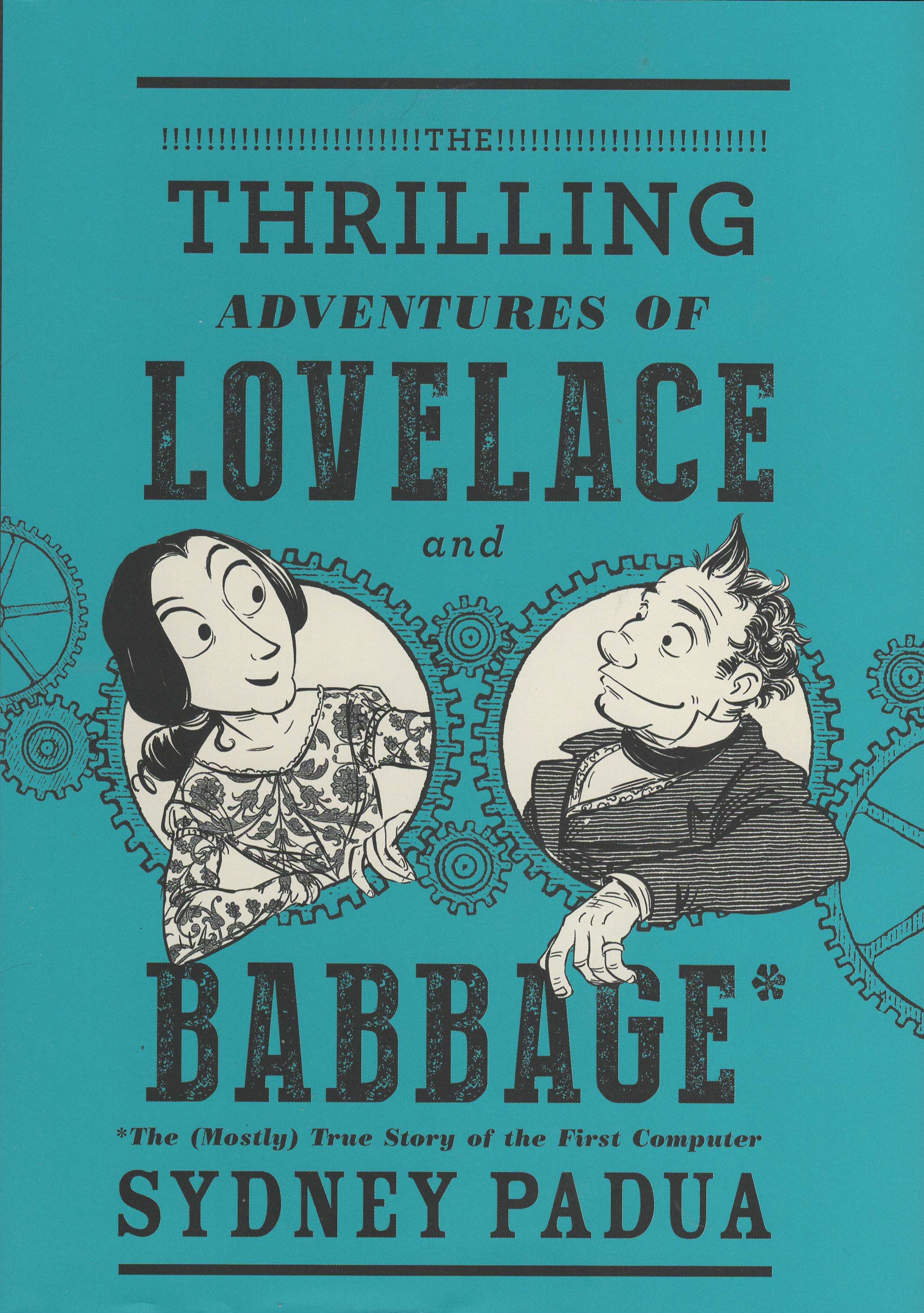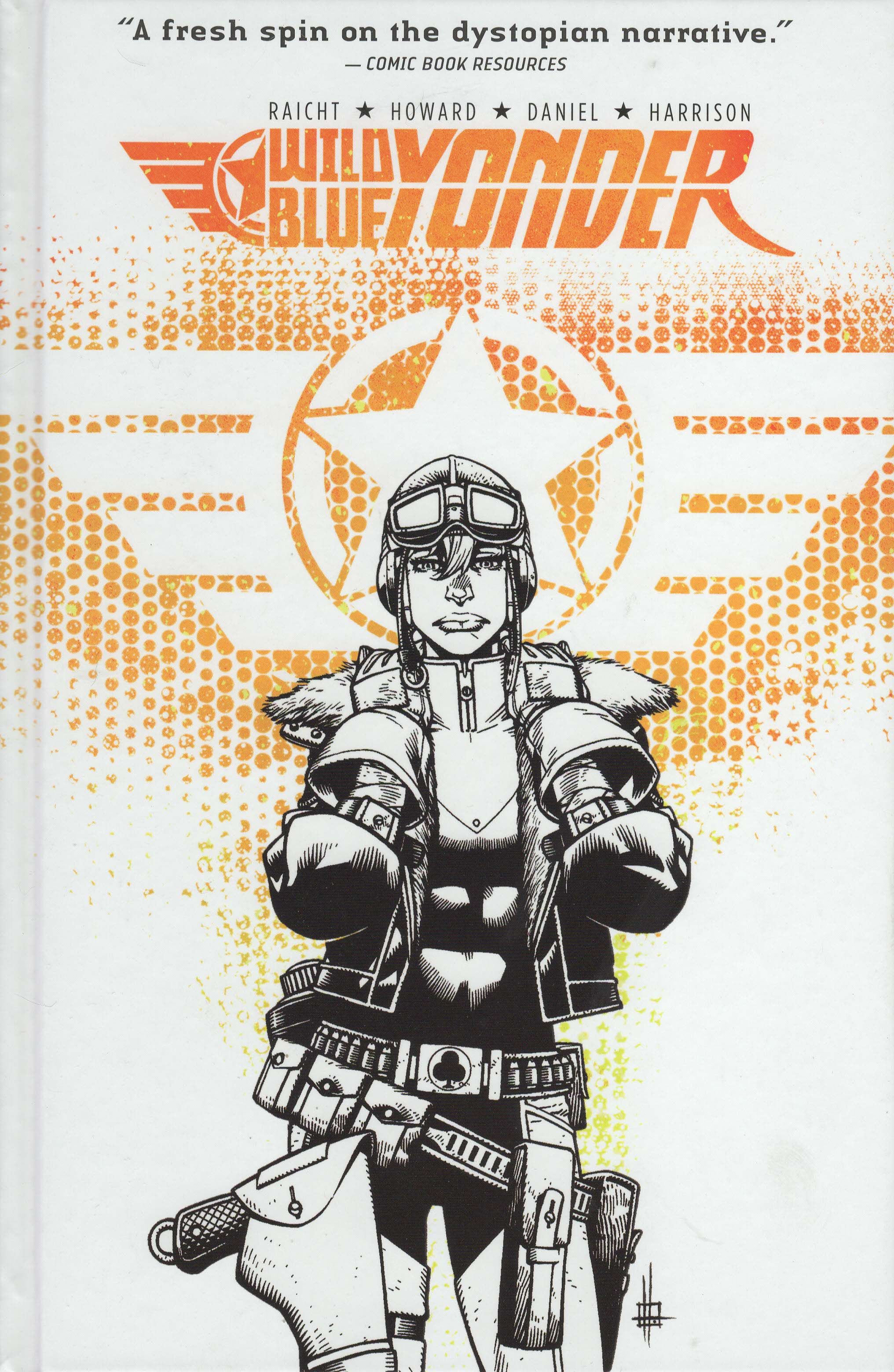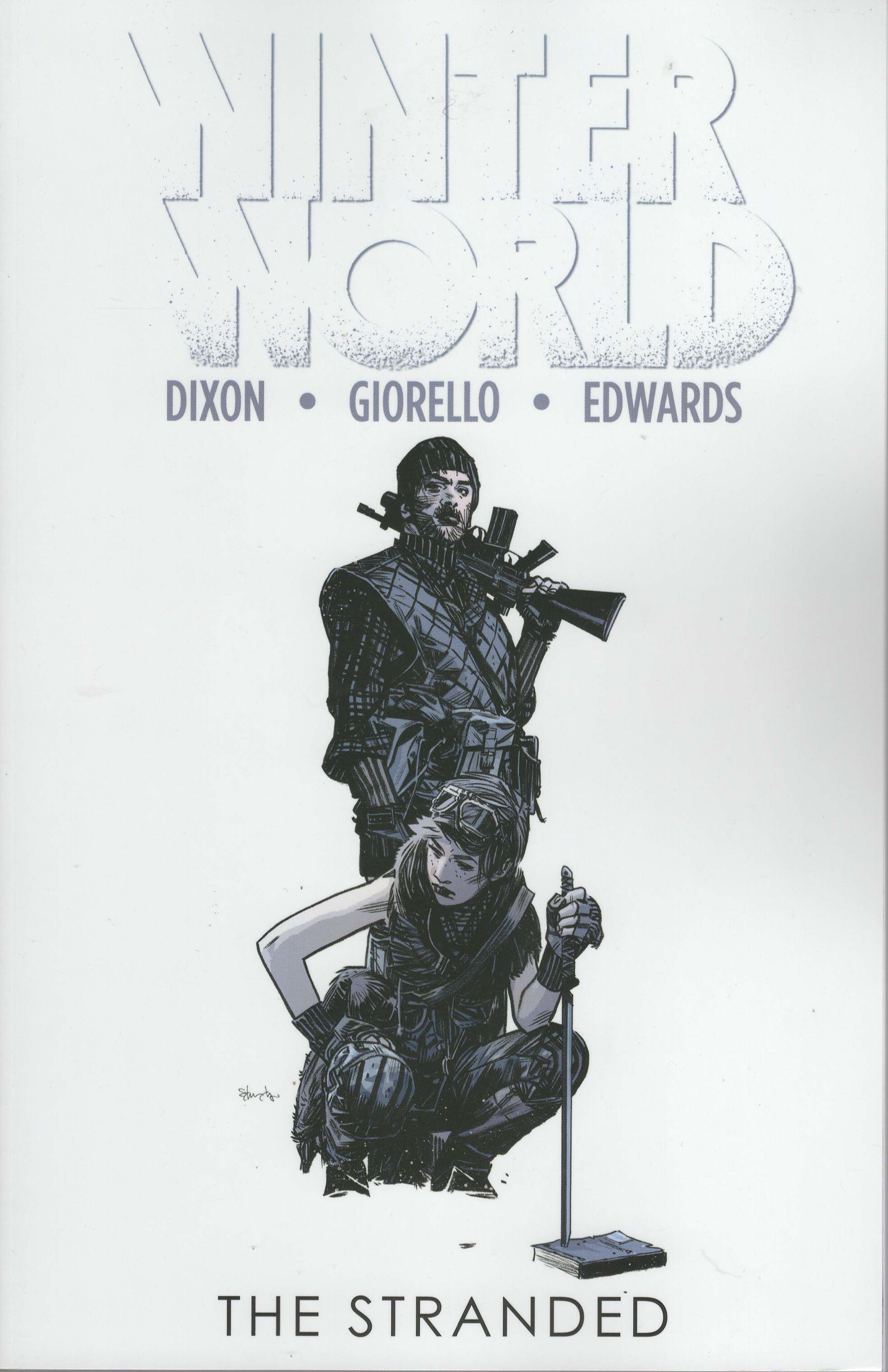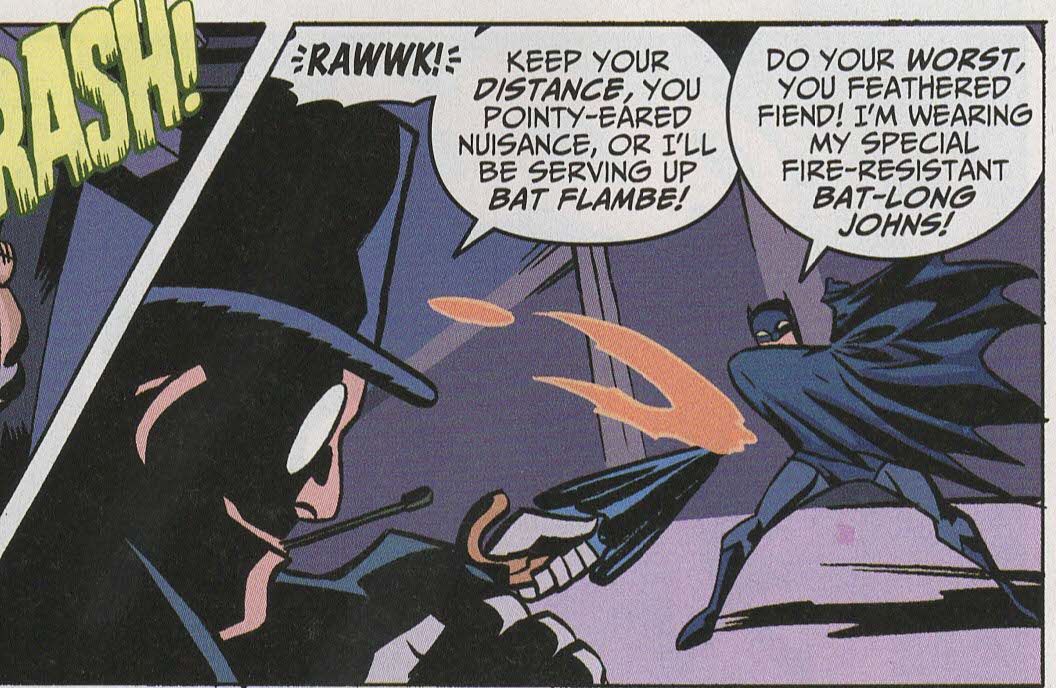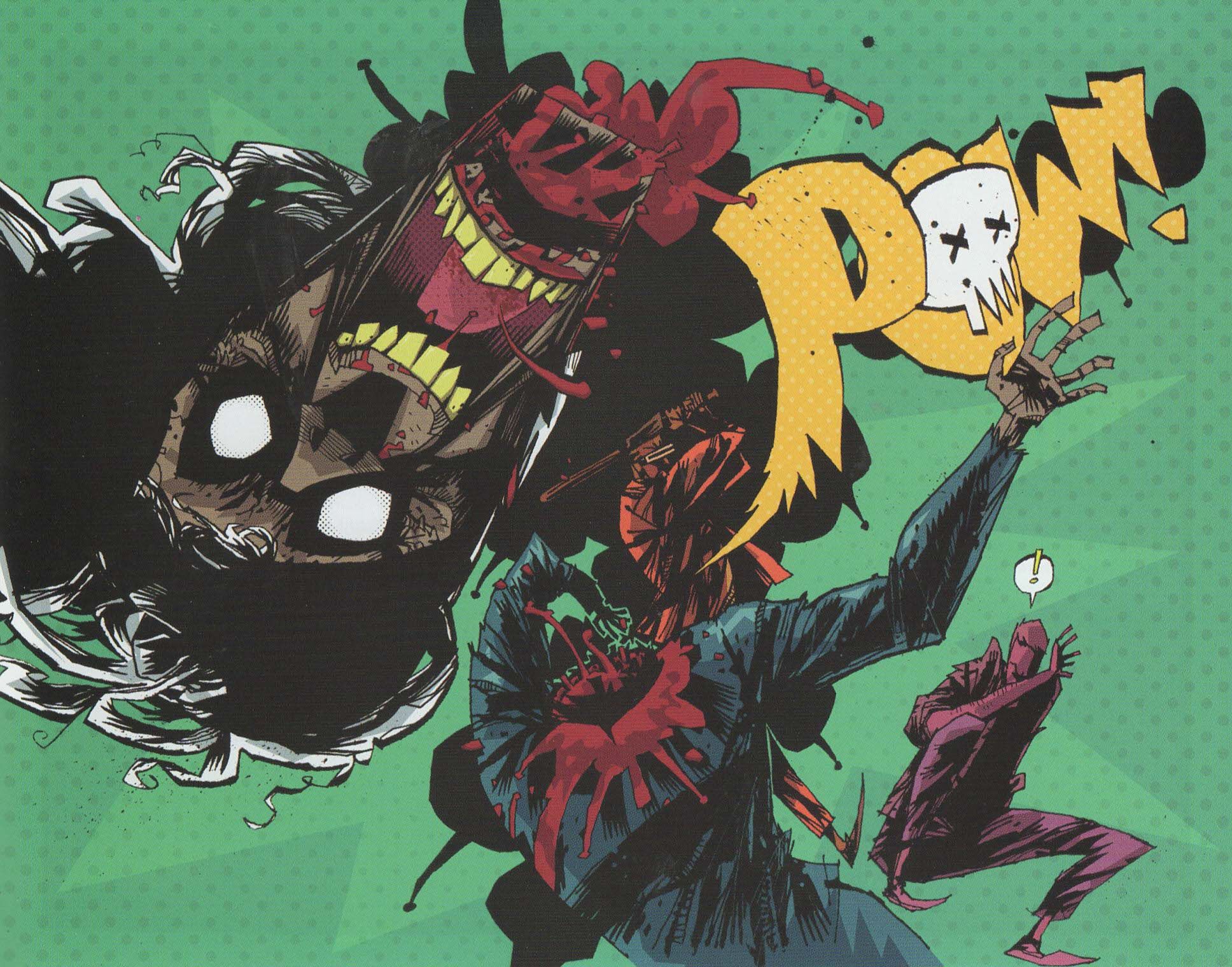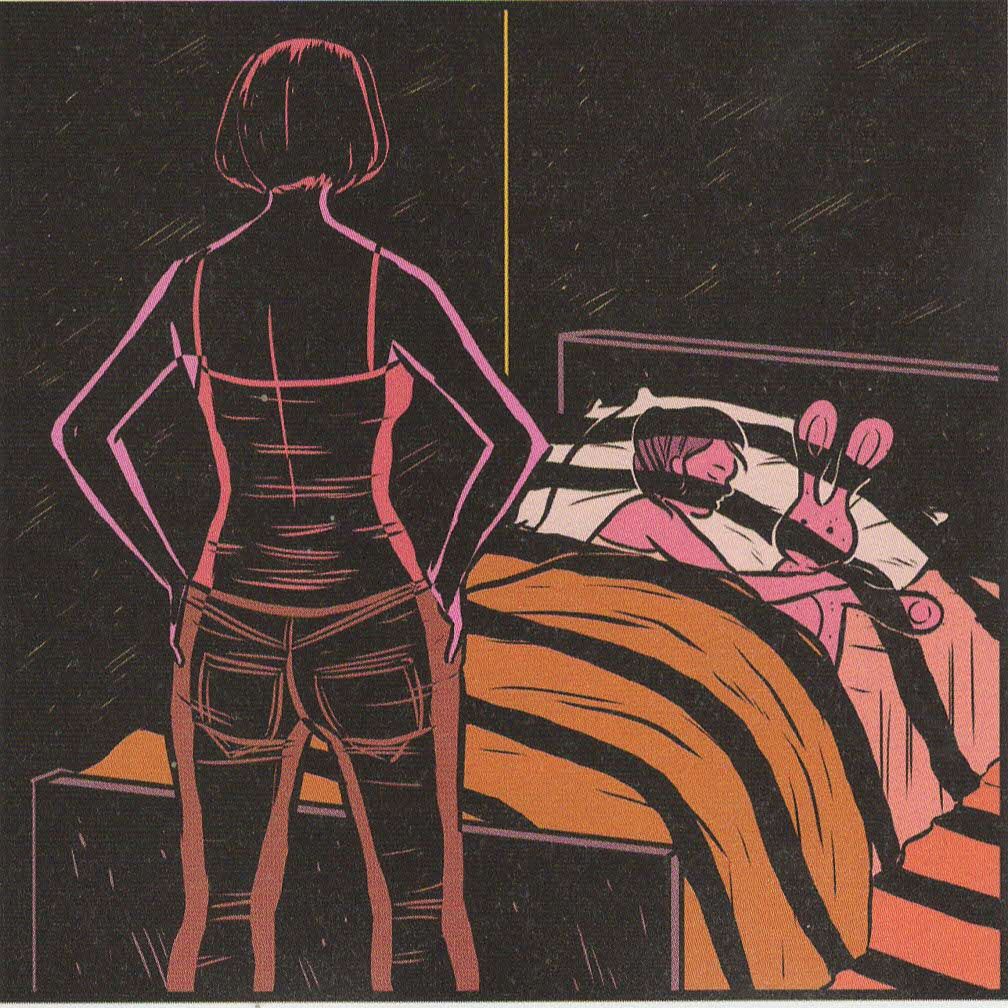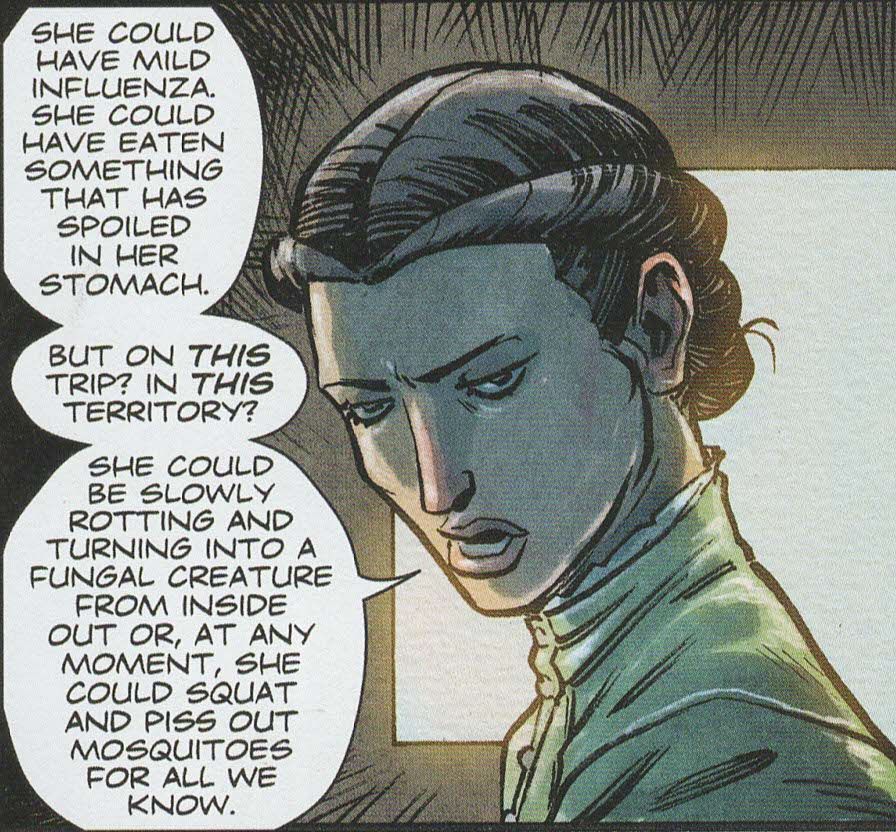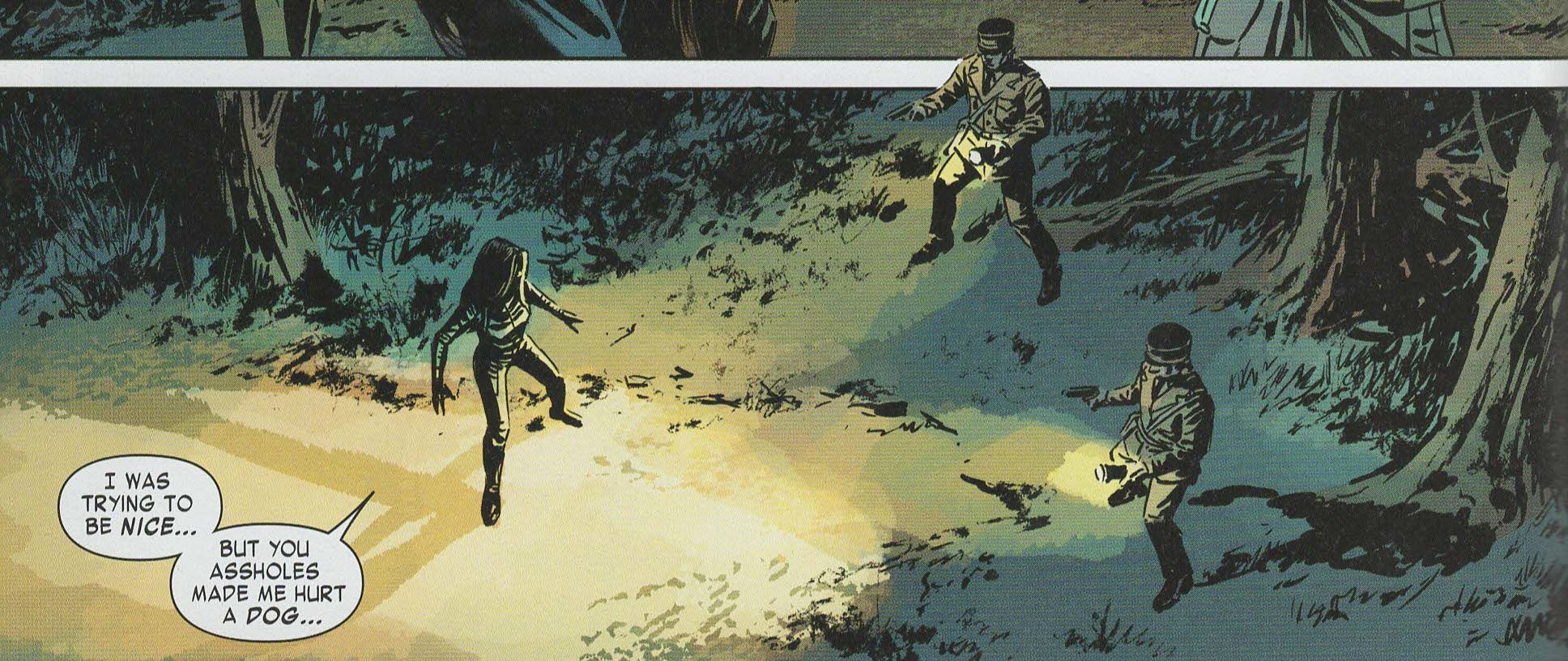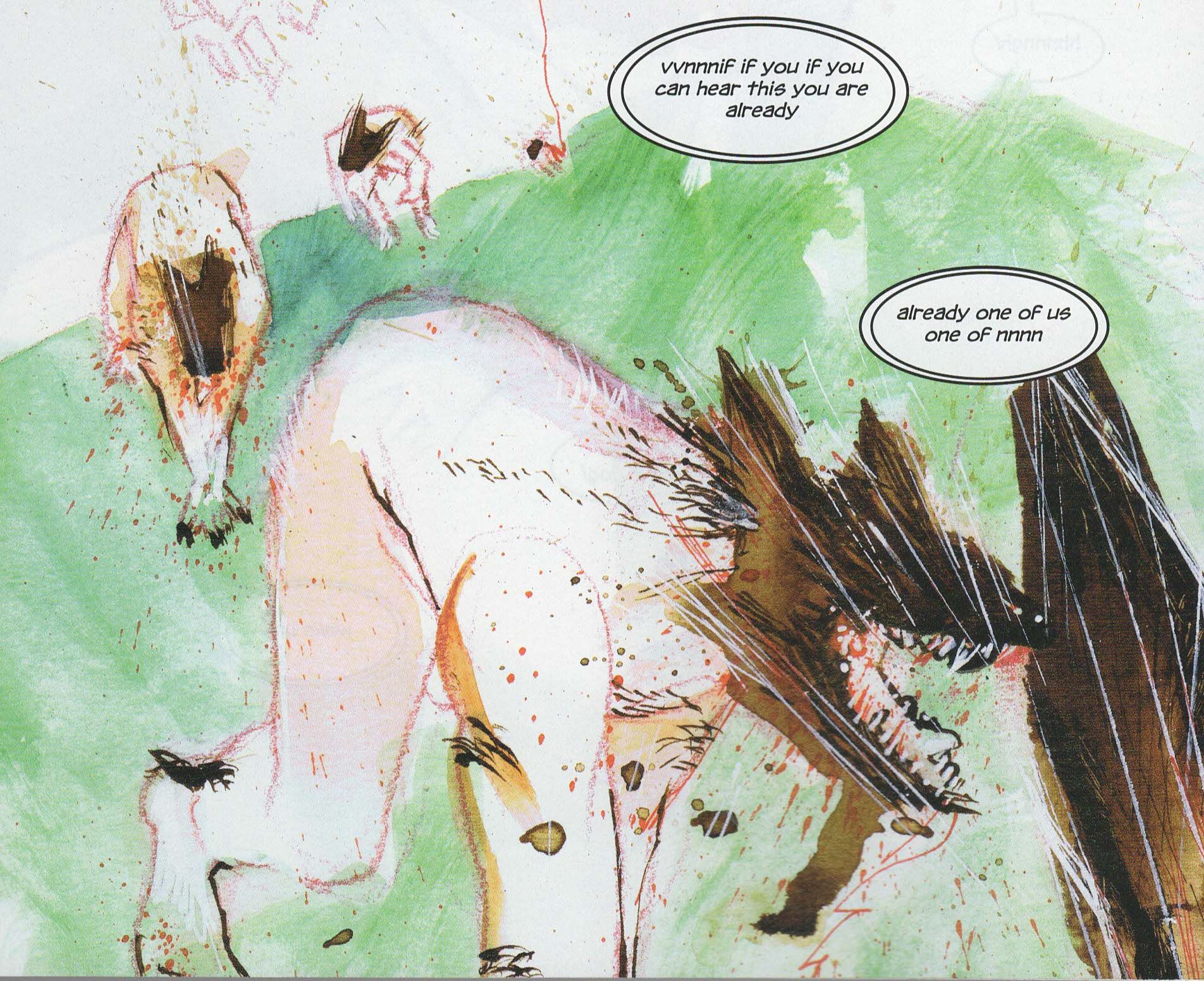"I couldn't. Absolutely. I know you work en route. And I like taxis. I was never good at geography and I learn things by asking the drivers where they come from."
"They come from horror and despair."
"Yes, exactly. One learns about the countries where unrest is occurring by riding the taxis here." (Don DeLillo, from Cosmopolis)
The Maxx: Maxximized #18 by Mike Heisler (letterer), Sam Kieth (story/artist), William Messner-Loebs (scripter), Ronda Pattison (colorist), Jim Sinclair (finisher), Michael Benedetto (assistant editor), and Scott Dunbier (editor). $3.99, 20 pgs, FC, IDW.
It's nice to get answers as we move forward in The Maxx - Kieth and Loebs have never been too obtuse about things, but the weirdness has stopped being just that and started pointing toward some answers, which is nice. I don't know how much of the art is "maxximized," but it's really amazing. Kieth can be a genius artist, and it's clear he was bringing his "A" game to this series. I know I'm late to the party, but this is a nifty comic.
Rating: ★ ★ ★ ★ ★ ★ ★ ½ ☆ ☆
One totally Airwolf panel:
The Infinite Loop #1 (of 6) by Elsa Charretier (artist/colorist), Pierrick Colinet (writer/letterer) and Sarah Gaydos (editor). $3.99, 24 pgs, FC, IDW.
Back matter in comics has become my bête noire recently, as it seems that creators tell us too much instead of letting the work stand by itself. After reading this terrific first issue of The Infinite Loop, I reached the back matter, and ... ugh. Here's what Elsa Charretier has to say about the book: "[It] delves into the difficulties to live a happy and fulfilling same-sex relationship when society won't fully allow you to." Okay. There's nothing wrong with that statement, of course, and it's not going to make me not read the comic. However, the first issue has just ended with the protagonist, Teddy, meeting (presumably) the girl of her dreams. There has been some talk of romantic attachment between Ulysses - the man in the comic - and Teddy, mostly because Ulysses is interested in it while Teddy remains unmoved by his charms, but at the end of the book, it's not necessarily clear that Teddy and the "anomaly" she meets are destined for a romance - there could be any number of reasons why Teddy is struck dumb by the woman. Then Charretier goes and tells us it's a romance, and more than that, she tells us that Teddy and the new character are going to have problems. Personally, I don't want to know that because the creator tells me, I'd rather find out from the text. Part of the reason Charretier does this is because she wants people to write letters about their first crush and when they realized they were "gay, lesbian, bi, queer, or trans, or the first time you met love," so I understand why she wrote about the comic in such a way, but I kind of wish she hadn't. Yes, these things vex me.
As for the comic itself, I mentioned that it's pretty terrific, and it is. Teddy is some kind of time engineer, who zips around to various time periods fixing anomalies that are caused by "time terrorists" trying to mess with stuff - like stopping Abraham Lincoln's birth, for instance. Ulysses is, I guess, the guy who finds the anomalies and other such things for Teddy to go fix, as he works in a cubicle in front of a computer and deals with things like protocol questions about Teddy's mission to make sure she hasn't been replaced by an "evil Teddy" (which also, helpfully, provides some exposition for us). At one point, they meet for dinner and Teddy explains to Ulysses how great it is that humanity has evolved past the need for base emotions, including love, which means it's at peace, as emotions always lead to violence. Of course, Teddy soon finds herself gazing at a beautiful woman, and it's obvious that despite her protestations, she's about to find herself swept up in an emotion.
It's a good set-up, although it's colored by what Charretier writes in the, you guessed it, back matter. Ulysses seems to be fine with same-sex relationships, but he also has a crush on Teddy, so is he being set up as a villain driven by jealousy? Neither Teddy nor Ulysses says that love is forbidden in their time, just that people choose not to indulge in it. So the idea of Teddy falling in love doesn't seem as dangerous as Charretier makes it out to be in the letters page, which is why it bugs me, as we're told there's going to be a conflict but we have no idea why, yet. Yes, Teddy herself might resist falling in love because she's so committed to not doing so, but that doesn't jive with the back matter. We don't yet have any idea about Teddy's "society," so it feels like the back matter is jumping the gun a bit too much. Before we get to the love part of the comic, Colinet brings up some weird plot points that Teddy can't figure out and which seem to indicate that this will be an adventure story. Of course, it can be both an adventure story and a love story, and I'm hoping for that. We'll see. Colinet does a nice job cramming a lot of information into this issue, and Teddy and Ulysses have good dialogue, as it's clear they're at ease with each other but remain a bit distant, as co-workers often are. It makes Ulysses's move on Teddy (he tries to kiss her) both believable and obviously inappropriate, but not in a horrible, creepy way. Colinet drops hints about same-sex relationships into the book well before Teddy is confronted with the woman at the end of the issue, and it should be interesting to see how the historical view of same-sex relationships plays into the comic. Perhaps the "society" that Charretier is writing about isn't Teddy's "home" society, but a society in which she's trapped for much of the book. We'll see, I guess.
Meanwhile, Charretier's art is amazing. This is the first time I've seen her work, mainly because I'm pretty sure it's her first American comic, and it's really wonderful. She uses a nice, clean line and a very fluid style to make even the conversation in the middle of the comic visually interesting (she uses black and white in one panel very effectively), but it's the scenes that bookend the comic where she really shines. Teddy's mission in the desert is interrupted by a Tyrannosaurus Rex, and Charretier lays out her attempts to deal with the dinosaur wonderfully, moving our eye really well around the page and even using a flow chart to add some levity to the proceedings (almost everything leads to the dinosaur eating Teddy, which of course doesn't happen). After her conversation with Ulysses, the two of them race through time (which is a common occurrence, apparently), and we get Escher-like pages of the two running on stair cases that twist back on themselves and infinitely long hallways and across pirate ships and through Miller's Court just before Mary Jane Kelly is killed (or at least that's what it looks like) until they slide down the pyramids and Ulysses tries to kiss Teddy, which Charretier draws beautifully because it really does look like Teddy has no objection to it until the last second, when she shuts it down. The final page is remarkable, as Charretier circles the two women with small, circular panels showing their faces as they stare into each others' eyes. The layouts, the line work, and the coloring on this book are terrific, and they take a good script and make it even better.
The Infinite Loop is off to a good start - Colinet has set up some intriguing plots, while Charretier's art is stunning. I still don't love the letters page, but what are you going to do, right? Go check it out!
Rating: ★ ★ ★ ★ ★ ★ ★ ★ ☆ ☆
One totally Airwolf panel:
Creepy #20. "Skinny" by Matthew Southworth (writer/artist); "Just Morphin' Around," "The King," and "Give a Dog a Bone" by Peter Bagge (scripter/artist) and Dan Braun (story/consulting editor); "Bowser" by Richard Corben (artist) and Jan Strnad (writer); "Verto" by Ramon Bachs (artist) and Kelly Thompson (writer); Ian Tucker (assistant editor), and Brendan Wright (editor). $3.99, 29 pgs, BW/FC, Dark Horse.
This is the first issue of Creepy I've bought, because usually there might be one creator (or team) I would really like to see but not enough of them to justify buying the entire comic. I've been looking forward to this issue since September, however, when Southworth told me the genesis of his story while I was talking to him at Rose City. And then I saw that Richard Corben was drawing a story and Kelly was writing one, so I figured this would be a good one to pick up. So I did!
"Skinny" is about a boy named Martin who finds a strange creature in the woods and decides to adopt it. But it's more than that, because Martin is a small boy who is the victim of a bully, Jimmy (the only false note in the story, in fact, is that a teacher kind of berates Martin after Jimmy bullies him - the teacher didn't actually see anything - which seems a bit ridiculous in today's culture), and his dad's not around. Skinny is a sickly creature, too, so Martin has to take care of it without revealing that he has a weird creature in his house. Southworth does a really nice job, in fact, with the many layers of the story. Martin pities Jimmy because Jimmy is an orphan, and Martin understands that maybe his bullying isn't all his fault. In many ways, Jimmy is Martin's only companion, too, until he gets Skinny. It's a nice story in that Southworth doesn't take sides - he shows Martin as someone who's far more compassionate than most kids, one who hates Jimmy for what he does but also can't stand to see Jimmy hurting, and he transfers that compassion to Skinny, with unfortunate results. The bleakness of the story seems to argue against being this way, as Martin grows up a little in the story but also retreats from the world, too, and Southworth doesn't give us any easy answers about how Martin should have acted with regard to Jimmy and Skinny. His art, as usual, is terrific - he uses thin lines for most of it, but when things get a bit darker, he thickens it just a little to bring home the brutality of one scene. He uses white gouache and gray tones wonderfully, adding beautiful dappling to the terrifying scene and a bit of light to the ending. Southworth's story would almost be worth the price of admission.
Strnad's and Corben's story is a throwback to the "funny" horror stories of eras past, something that Corben's somewhat goofy art is very well suited for. A young boy has a monster in his basement, and so of course wacky things are going to happen. Strnad gives us a not-so-subtle satire of suburbia and the cheeriness of parents, who are partners in crime with Timmy and Bowser. It's a slight story, but well done. Meanwhile, the chameleon that is Ramon Bachs does a superb job with Kelly's story of a girl raising bugs in her bedroom. I first saw Bachs's art when he drew David Lapham's "City of Crime" in Detective Comics, and in the years since, he seems to shift styles with every project even as he remains noticeably "Bachs." Here his line is a bit slicker, as he seems to use a thin brush to create a non-threatening environment that quickly turns creepy at the end. The only real problem I have with the story is that I'm not entirely sure why everyone seems fine with giant cockroaches. Anna doesn't seem fazed by the rapidly expanding bug, and when she takes another one to school, all the kids seem to be part of this giant-bug-raising collective. It lessens the impact of the ending a bit, because what happens seems to be easily anticipated once you start raising cockroaches as big as dogs. Still, Kelly does a nice job showing Anna acting like a regular teenager, which makes the ending a bit more icky. But I don't think I get it, not totally.
Peter Bagge's one-page cartoons come between the stories, and they're, well, Peter Bagge cartoons. Whether that's your thing or not is up to you.
This is a pretty neat issue of Creepy, and if you've been on the fence about getting yet another anthology series, it's a good one to check out. I'm just worried that Kelly is going to take over the comics world too quickly and not talk to any of us anymore!!!!
Rating: ★ ★ ★ ★ ★ ★ ★ ½ ☆ ☆
One totally Airwolf panel:
Batman '66 #22 ("The Penguin Turns the Tables/Batman Shows He's Able") by Wes Abbott (letterer), Tony Aviña (colorist), Mike W. Barr (writer), Michael Avon Oeming (artist), Jim Chadwick (senior editor). $2.99, 20 pgs, FC, DC.
Mike W. Barr is probably the last writer to write the "real" Batman with any sense of humor, and that was a long, LONG time ago, so it's perhaps not surprising that DC got him to write an issue of Batman '66, as it's as close to "Barr's Batman" as we get these days. He gives us a Penguin who decides to stop basing his crimes on umbrellas and decides to, well, turn the tables of the Caped Crusader. Interestingly enough, in a comic that isn't known for subtlety, Barr either forgets or leaves it up to us to figure out the reason for one of the Penguin's crimes - there's one panel that clues us in, but it's all the artwork, which is kind of keen even if it's unintentional. This is, like pretty much every issue of Batman '66, a solid story, with Batman using his brain to figure things out (I know, imagine that) and Barr throwing just enough goofiness in the mix to remind us where we are. Oeming would seem like a pretty good fit for this comic, but I'm not a fan of his art in this issue. There's one panel where the Penguin strides away that's one of the worst drawings of Oswald I've ever seen, but even if we ignore that, Oeming seems to have problems with the art. The Penguin's face is weird, his Batman is a bit too lanky, and Oeming's general facial work - never his strong suit - seems even a bit less impressive than usual. Plus, his somewhat angular style clashes with some of the more action-packed scenes - Oeming seems like he would be better at action because he's a bit cartoony, but I've never loved his action scenes, and here it's fairly obvious that they're not great. I don't know - Oeming has never been my favorite artist, but he's not bad, and this issue just doesn't look all that great. Oh well.
Still, it's Batman not chasing down the Penguin because he wants to make sure that the bats the Penguin genetically altered are safe. I like this Batman!
Rating: ★ ★ ★ ★ ★ ★ ½ ☆ ☆ ☆
One totally Airwolf panel:
Grindhouse: Drive In, Bleed Out #4 ("Blood Lagoon Part 2 of 2") by Alex de Campi (writer/letterer), Chris Peterson (artist), Nolan Woodard (colorist), Ian Tucker (assistant editor), and Brendan Wright (editor). $3.99, 24 pgs, FC, Dark Horse.
I get that de Campi is writing these comics as if they're exploitation movies from the 1970s - it's part of what makes the book so much fun - but I'm really having a hard time figuring out why Garcia takes her shirt off to fight the big monster at the bottom of the lake. Is it because she doesn't want to ruin said shirt? If so, why doesn't she put it back on at the end of the comic instead of draping herself in a ragged Confederate flag that she took from Wayne's dad's house? And why isn't she wearing a bra - her boobs are big enough that it would seem uncomfortable to be wandering around without one. And somehow she loses her panties underwater, but it's very unclear how. These are serious questions, people!!!!
Okay, they're not really serious. But this isn't really a serious comic. I mean, it features a half-cybernetic sheriff stripping almost naked (except for her rainbow panties) to fight an alien monster that makes ticks grow to giant size, so I think "serious" has been left far behind. But it remains quite a fun comic, so there's that!
Rating: ★ ★ ★ ★ ★ ★ ★ ☆ ☆ ☆
One totally Airwolf panel:
Miami Vice: Remix #2 (of 5) by Joe Casey (writer), Jim Mahfood (artist/letterer), Justin Stewart (colorist), and Shannon Eric Denton (editor). $3.99, 24 pgs, FC, IDW/Lion Forge.
I'm sure if some hardcore Miami Vice fans read this (are there any hardcore Miami Vice fans out there these days?), they might be upset, as Casey is writing this and Mahfood is drawing this as if they found some particularly good meth, but it's just wildly entertaining. Casey never lets anyone catch their breath, and even "quiet" scenes like Crockett's and Tubbs's visit to a porn set is pretty wacky. Casey, unsatisfied with the two plots already running, introduces a third in this issue, because why wouldn't he? Casey usually gets good artists, which is nice, and Mahfood is a good fit for his high-adrenaline writing style. There's a lot to like about this series so far, but I'm not sure if it will sit well with people expecting 1980s moodiness. You're just not going to get that here.
Rating: ★ ★ ★ ★ ★ ★ ★ ☆ ☆ ☆
One totally Airwolf panel:
Mind MGMT #32 ("The Immortals Chapter 2") by Matt Kindt (writer/artist), Ian Tucker (assistant editor), and Brendan Wright (editor). $3.99, 25 pgs, FC, Dark Horse.
As the last arc moseys along, Kindt checks in with Perrier and Duncan as they search for people to join them in their battle against the Eraser. What's fascinating about this particular issue is that Kindt really gets into the cost of being a Mind Management agent. That's been a long-running theme of the series, of course, but in this issue, Kindt focuses on that even more, as the characters Duncan and Perrier visit are varying degrees of insane or, in one case, disemboweled (see below). The final dude they visit seems fine, but they're attacked immediately upon meeting him, which is no way to live. Mind Management, obviously, is not the place for the most stable of people, but Kindt does a nice job concentrating on that aspect of the group and its members in this issue, and it shows what a terrifying world these characters live in. The question remains: What happens if Meru succeeds in stopping the Eraser? These people are still out there, poisoning oranges and serial killing. Yeah, that's not fun.
There's not much else to say, as the book has been good from the get-go and now it's winding down. Get the trades!
Rating: ★ ★ ★ ★ ★ ★ ★ ★ ☆ ☆
One totally Airwolf panel:
Curb Stomp #3 (of 4) by Colin Bell (letterer), Ryan Ferrier (writer), Jeremy Lawson (colorist), Devaki Neogi (artist), Jasmine Amiri (associate editor), and Eric Harburn (editor). $3.99, 22 pgs, FC, Boom! Studios.
As I noted last issue, Curb Stomp isn't that great, but I am impressed by Ferrier's willingness to devastate his main cast - no one is safe in this comic, and while I'm not generally the bloodthirsty type, I usually reserve that for superhero comics with characters the writer didn't invent - in creator-owned stuff, all bets are off! It does add a sense of menace to the story - on the one hand, in the final issue, I can guarantee that one character is safe, but otherwise, who knows?
There's more double-crossing in this issue, including by someone everyone should have known would betray everyone, and lots of poop hits the fan. The problem, as it has been with the first two issues, is that Ferrier tends to hit all the notes we expect - even the one character's death isn't too surprising because of the way Ferrier sets up the killer, so the only surprise is the identity of the victim. The double-crossing feels rote, as if that character is just supposed to betray everyone else and so it happens. Obviously, I don't want to say too much, but this has been a frustrating series, because Ferrier isn't trying to do anything interesting, so any entertainment value of the comic is blunted by the by-the-numbers plotting. Neogi isn't a bad artist, but she has a lot of room to improve, so it's not even like the artwork can carry the story. It's too bad.
I mildly curious about how Ferrier winds up the story, but given what we've seen so far, it doesn't appear that he'll completely redeem it. But we shall see, won't we?
Rating: ★ ★ ★ ★ ★ ½ ☆ ☆ ☆ ☆
One totally Airwolf panel:
Chew #48 ("Blood Puddin' Part 3 of 5") by Rob Guillory (artist/colorist), John Layman (writer/letterer), and Taylor Wells (color assistant). $2.99, 20 pgs, FC, Image.
I've been in the bad for Chew pretty much since the first issue, and Layman is a friend of mine, so I know I'm probably not terribly subjective on the topic, but it really is an impressive comic. Layman comes up with food-based abilities seemingly in his sleep, with this issue giving us a team of assassins with gelatin-based abilities (the "jellassassins") that work for the Collector but end up not being very formidable. What might seem like a waste of two pages instead is just a way for Layman to have some fun with even more weird characters, and while it might not work in a more "serious" comic, the fact that a good deal of this series is tongue-in-cheek makes it far less egregious. Layman certainly doesn't waste space in the book, as we get a lot of plot developments in the ongoing saga of the Big Bad, but what makes Chew so good is despite how outlandish the situations and the characters are (yes, the cover of this book is accurate and that happens to Applebee and Caesar), there's still some terrific characterization. Tony learns things about himself that he doesn't like, and he realizes he needs Colby's help, which of course makes Colby panic because of what he did the past few issues to help Tony and which he stopped doing because Tony was being a dick. So even while we get a nice moment between the two characters, we get the humor of Colby realizing that he can still help Tony but it might be too late. The book can still be goofy, but as Layman moves toward the end game, he's delving more into how Tony has failed as a father and how he has to make it right. It's well done.
Guillory, unfortunately, doesn't get to draw as much wackiness as he usually does, but it's still a wonderful-looking comic. Guillory does such a great job with exaggerated facial expressions that fit the tone of the book but also get across the raw emotions of the characters, and in this issue, at least, that's important, as the action is just slightly toned down (I mean, there's still a splash page of Olive, Savoy, and Amelia fighting the jellassassins, but that's just one page). Guillory is always good on the comic, and it's nice to see him do solid stuff on a relatively quieter comic.
Chew is hurtling toward its end, and things are getting more intense. It should be fun!
Rating: ★ ★ ★ ★ ★ ★ ★ ★ ☆ ☆
One totally Airwolf panel:
Drones #1 (of 5) ("Now Playing") by Anderson Cabral (colorist), E.T. Dollman (letterer), Chris Lewis (writer), Bruno Oliveira (artist), Andy Schmidt (consulting editor), Bobby Curnow (consulting editor), and Jon Hogan (story editor). $3.99, 22 pgs, FC, IDW/Comics Experience.
Back in July, when I went to San Diego, I learned about IDW teaming up with various digital publishers to print their stuff. One of those collaborations was with Lion Forge, which has cornered the market on 1980s properties, it seems, and which brought us Miami Vice: Remix (see above). Comics Experience, which Andy Schmidt started to help people trying to break into the comics field, is another one - the creators at CE do stuff, presumably as part of the curriculum, and eventually, IDW publishes some of it. They have some interesting comics coming up, and Drones is the first one that sounded pretty keen.
The concept is the tiniest bit ridiculous, but given what kinds of things we see in the real world these days, it's not outside the realm of possibility. Lewis wants to examine the connection between war, entertainment, and sex, so I'm kind of hoping things get even weirder than they do in this issue. It's not that this issue is all the weird, but it does hint at some dark and disturbing things, which I whole-heartedly endorse. The basic premise, as I mentioned, is a bit ridiculous - there's a terrorism-themed hotel in Las Vegas. The reason why this seems ridiculous is not because Americans don't appreciate the connection between war, entertainment, and sex, but because Americans tend to be uptight about it being so obvious. While Lewis writes in the back matter (sigh) about the video game nature of the Gulf Wars and watching it on television (with, yes, the penetration and explosions), and I have no doubt that plenty of Americans get at least a little thrill out of watching people get killed, it's usually so couched in metaphor that it's impossible to approach in the concrete. Yet that's what Lewis is doing, and bringing it into the world of the real as opposed to the world of metaphor blunts the satire just a bit, at least in this first issue. The sex between Stinger and Parvati is the creepiest part of the book, because Parvati insists on recording it and Stinger is afraid he can't perform with that added pressure plus the fact that he's just spent hours "performing" with drone strikes, but it's still a little too on-the-nose. The idea that the terrorism-based hotel would have custom-made abductions is clever, as it allows Stinger to relax even though we're not sure if Lani was kidnapped by the hotel or actual terrorists or, indeed, if there's any difference between the two. If you can accept that fact that in this world, enough Americans wouldn't be hypocritically protesting against something as sacrilegious as a terrorism-based resort, then the book works pretty well. It's a decent set-up, even if Lewis makes the connections a bit too obvious.
Oliveira does a decent job with the art, although some things are a bit bizarre from a perspective and layout point of view - there's a scene where Stinger is flying a drone in Las Vegas, and the panel is too cramped for it to look as expansive as it probably should, and the double-page splash of the resort is, if anything, still a bit too cramped, as Oliveira doesn't make good enough use of the space he's afforded. Generally, it's not bad - there's a Mateus Santolouco vibe to his work, which isn't a bad thing at all. He does a good job with the facial expressions of the characters, as they're interacting with each other quite a bit, and the quiet moments are better than the bigger, more action-packed moments. Stinger and Parvati have a good relationship - Lewis writes them well, while Oliveira does a nice job with their flirting and their arguments. It makes Lewis's script work better because we get a good idea of these two in different situations, so when Parvati is "abducted" (if she actually is), it makes Stinger's worrying about her feel more real.
This is a solid beginning, even though once again, Lewis tells too much in the back matter than should be shown in the issue. But that's the way of the world, I suppose, and we'll just have to live with it. IDW and Comics Experience have a few intriguing comics coming out soon (and, to be fair, this isn't the first one, but it's the first one I've been interested in), and more comics in the world is never a bad thing, is it?
Rating: ★ ★ ★ ★ ★ ★ ★ ☆ ☆ ☆
One totally Airwolf panel:
Manifest Destiny #14 by Pat Brosseau (letterer), Chris Dingess (writer), Owen Gieni (colorist), Matthew Roberts (artist), and Sean Mackiewicz (editor). $2.99, 20 pgs, FC, Image/Skybound.
The humor of a man getting carried away by a giant bird creature but leaving his boots behind is a bit lost on me, unfortunately. I mean, yes, Roberts draws it beautifully - we get a splash page of the bird creature flying through the air with a man dangling, terrified, from its claws, with Lewis and Clark's ship far below - but while I'm pretty sure it wasn't supposed to be laugh-out-loud funny, it seems like it's supposed to elicit a chuckle from the readers. But why would the dude's boots come off? I mean, those are some poor-fitting boots, I imagine, if they come off in that situation. Yes, these are the things I think about when I'm reading comics. That's why you come here for such trenchant observations!
One thing I need to do is go back and read the entire series and see how many men are on this furshlugginer boat in the first place. It seems like the expedition loses men but they never seem to be undermanned, and I'm very curious if Fricke has shown up prior to this issue, because you think we would have noticed him. It makes me wonder how far in advance Dingess plotted this thing out - he obviously has a big story to tell, so I'm curious if he's tightly plotted out the entire series or just a vague outline - because the boat doesn't look that big, and we can't keep losing random crew members like we do in this issue! Poor random crew member - we hardly knew ye.
The book continues to be really good, though, as we're still dealing with weird creatures - although I have a feeling this one is nicer than Lewis and Clark might think - and tension between the men and Sacagawea being sick and hating everyone and Mrs. Boniface standing up to the menfolk but still hating Sacagawea. Oh, there's a lot going on, to be sure!
I don't know, I just really like the comic. It's neat-o.
Rating: ★ ★ ★ ★ ★ ★ ★ ½ ☆ ☆
One totally Airwolf panel:
Velvet #10 ("The Secret Lives of Dead Men Part 5") by Elizabeth Breitweiser (colorist), Ed Brubaker (writer), Chris Eliopoulos (letterer), Steve Epting (artist), and Eric Stephenson (editor). $3.50, 23 pgs, FC, Image.
Ed Brubaker obviously read my criticism of the previous issue of Velvet, as the first few pages sees our heroine castigating herself for being so stupid as to leave Damian Lake unattended when he went to the bathroom. So she spends a good deal of the issue on the run from the gendarmes until she gets caught by her own employers, which ... well, I wouldn't want to spoil anything. Brubaker manages to make some allowances for the fact that Damian somehow set up a big trap for Velvet, but it still feels a bit too much like the Joker having schemes that he couldn't have come up with in such a short time. How did Damian manage all this? Hasn't he been in prison? I could go back and check earlier issues, but ain't nobody got time for that. So this becomes an artistic spotlight, because basically Brubaker just wants Velvet to run around fighting and/or escaping from the French police. Epting is up to the task, naturally, as he's been doing such good work on this series. His fight scenes are fluid and brutal, while he gives us a good sense of Velvet moving through a rural landscape. Breitweiser, unfortunately, doesn't get much of a chance to do good work with the coloring - she sticks to a blue palette with yellow complements, which is fine but is often far too dark. The epilogue, with its oranges and reds, is a bit better, but the fact that the entire comic takes place at night doesn't do it any favors. When a colorist (and a creative team in general) wants to be "realistic," we often get very dark comics like this, with a lot of shadows and blues. Velvet wants to be realistic, and that's fine, but you have to take the good with the bad with regard to that.
Brubaker mentions in the letters page that they have a new editorial coordinator, which will make the book come out faster. I don't get this, although I do appreciate that Brubaker wants to get the book out on a more regular schedule. But the book is beautiful, and I don't know if it would be less so coming out faster. I mean, Brubaker isn't telling single-issue stories, after all. We're all reading this as a big giant story, so what's the rush? Maybe Brubaker thinks sales will improve. Maybe that's it, but I hope that if the book comes out in a more timely fashion, it still looks as good as it always has. That would be nice.
Rating: ★ ★ ★ ★ ★ ★ ★ ½ ☆ ☆
One totally Airwolf panel:
Intersect #6 by Ray Fawkes (writer/artist). $3.50, 20 pgs, FC, Image.
This is the last issue of Intersect that I'm getting - I've mentioned over the past few issues that it's just not doing it for me. Fawkes's art is very nice, but despite the fact that he finally got to a point in the past few issues, I still don't feel anything for the characters or the state they find themselves in. This is a weird world, but it's just not that interesting, and the climax of the arc isn't as powerful as it could be because I don't care about the characters at all. It's too bad. I like Fawkes, and he can do nice work, but I guess I'm just not esoteric enough to appreciate this. Such is life. I wish it the best, but I won't be back.
Rating: ★ ★ ★ ★ ½ ☆ ☆ ☆ ☆ ☆
One totally Airwolf panel:
Th Adventures of Basil and Moebius volume 1. "The Curse of Spring-Heel Jack" by Larry Hama (writer), Jeff Huet (inker), Ross Hughes (colorist), Ryan Schifrin (writer), Dave Sharpe (letterer), and Rey Villegas (penciler); "The Bloodstone Caper" by Larry Hama (adapter), Lizzy John (artist), Novo Malgapo (artist), Ryan Schifrin (writer), and Dave Sharpe (letterer); "The Devil's Handshake" by Adam Archer (artist), Ed Dukeshire (letterer), Larry Hama (writer), Lizzy John (artist), and Ryan Schifrin (writer). $19.99, 155 pgs, FC, Magnetic Press.
I don't know when these were first published, but this is a collection of older stuff. I actually own "The Devil's Handshake," and it came out in 2009, so who knows when the others one showed up. "The Devil's Handshake" isn't bad, so I'm curious to see what the other ones are like.
Fight Like a Girl volume 1: Learning Curve by David Pinckney (writer), Soo Lee (artist), and Adam Wollet (letterer). $14.99, 91 pgs, FC, Action Lab.
This looks pretty good, although it's weird that Action Lab reprints every single thing in each issue, including the advertisements for other comics in their line, in the trade. Odd. Anyway, I got this because I figure if I don't like it, my daughter probably will. That's what's cool about having a kid who likes comics!
Hulk: Future Imperfect by Peter David (writer), Dan Kemp (colorist), Dale Keown (penciler), Livesay (inker), George Pérez (artist), Joe Rosen (letterer), Tom Smith (colorist), Joe Weems (inker), John Workman (letterer), and Mark D. Beazley (collection editor). $19.99, 143 pgs, FC, Marvel.
I own Hulk: The End and I've read Future Imperfect, but I never owned it, so I figured I'd pick this up. Future Imperfect is really good, y'all.
The Thrilling Adventures of Lovelace and Babbage by Sydney Padua (writer/artist). $28.95, 317 pgs, BW, Pantheon Books.
On the back of this comic, James Gleick, who's written some books I enjoy, gives a blurb that includes "Don't be fooled by the word 'comic.'" Won't it be nice when the day arrives that even praise doesn't need to qualify that this isn't your stereotypical comic book? I mean, Fun Home did win Book of the Year. Sheesh.
Wild Blue Yonder by Nelson Dániel (colorist), Zach Howard (story/artist), Austin Harrison (story), Thompson Knox (letterer), Mike Raicht (story/writer), Jolyon Yates (inking assistant), and Bobby Curnow (editor). $29.99, 155 pgs, FC, IDW.
Post-apocalyptic fighter pilots? Yeah, this looks pretty keen.
Winterworld volume 2: The Stranded by Chuck Dixon (writer), Tommy Lee Edwards (artist), Tomás Giorello (artist), Robbie Robbins (letterer), Diego Rodriguez (colorist), John Workman (letterer), and David Hedgecock (editor). $17.99, 78 pgs, FC, IDW.
I wish these Winterworld collections were longer, because they're pretty good. I mean, 18 bucks for this is pretty dear.
Witchfinder volume 3: The Mysteries of Unland by Tyler Crook (artist), Maura McHugh (writer), Kim Newman (writer), Clem Robins (letterer), Dave Stewart (colorist), Shantel LaRocque (assistant editor), and Scott Allie (editor). $19.99, 110 pgs, FC, Dark Horse.
Yay, Victorian horror stories!!!
Money spent this week: $174.17. YTD: $1962.94.
**********
These posts have been ridiculously late the past two weeks because my wife has been working from home while my daughter recovers from her back surgery. Our ISP is terrible - we're looking into switching to a better one - and when she uses the system that her employers use, the traffic is so high that things at home get clogged up. When I'm on the Internet, her work space slows to a crawl, and she can't get any work done. As it's actual work and this ... isn't, I haven't been able to do anything on Thursdays and Fridays, when I usually do most of the work on these posts. I can work on the weekend, but there are other distractions, of course, because my other daughter is home. So I apologize for being late with these and if they're not up to whatever standard I may have set in the past (whether it's a good standard or not is up to you!). My daughter is doing pretty well and I think my wife is going back to her office this week, so maybe this will be posted sooner next week. Thanks for your patience!
Have a nice day, everyone! Free Comic Book Day is next Saturday, so be sure to head out and pick some cool stuff up. You know you want to!

